Research faces uncertainty
By ASHLEY WEI the daily northwestern
Nearly six months after the Trump administration froze $790 million in federal funding for Northwestern, faculty continue to confront a new academic research reality amid national changes. An uncertain future remains a paramount concern for researchers as they adapt to funding freezes, hiring halts and staff cuts.
On April 8, the same day it froze NU’s funds, the federal government issued around 100 stop-work orders. The freeze primarily targets grants from the Departments of Agriculture, Defense, Education and Health and Human Services, which are awarded via federal agencies such as the National Science Foundation and the National Institutes of Health.
As a dark outlook for projects’ futures loomed, NU announced its commitment to financially support research affected by the freeze a week later.
But the University couldn’t
stop the bleed without a cost. NU announced they were initiating a faculty and staff hiring freeze on June 10 and eliminating more than 400 staff positions — half of which were vacant at the time — at the end of July.
Since then, NU’s research community has adjusted to these developments in order to continue research.
Some researchers appreciate University aid, but sacrifices are still made
Molecular biosciences Prof. Curt Horvath researches immune responses to virus infections and cancer. The grant that funded his work was affected by the freeze, he said.
While Horvath expressed gratitude for the University’s support, especially as it suffers financially from the added costs, he acknowledged that he still has to make adjustments by cutting “nonessential programs,” since NU is unable to fully offset the funding.
“We’ve been really lucky that Northwestern University has adopted a policy to help to cover some of those costs, even though it’s incurring a pretty big debt to the University while they try to sort it Faculty navigate federal funding freeze
» See FUNDS , page 14
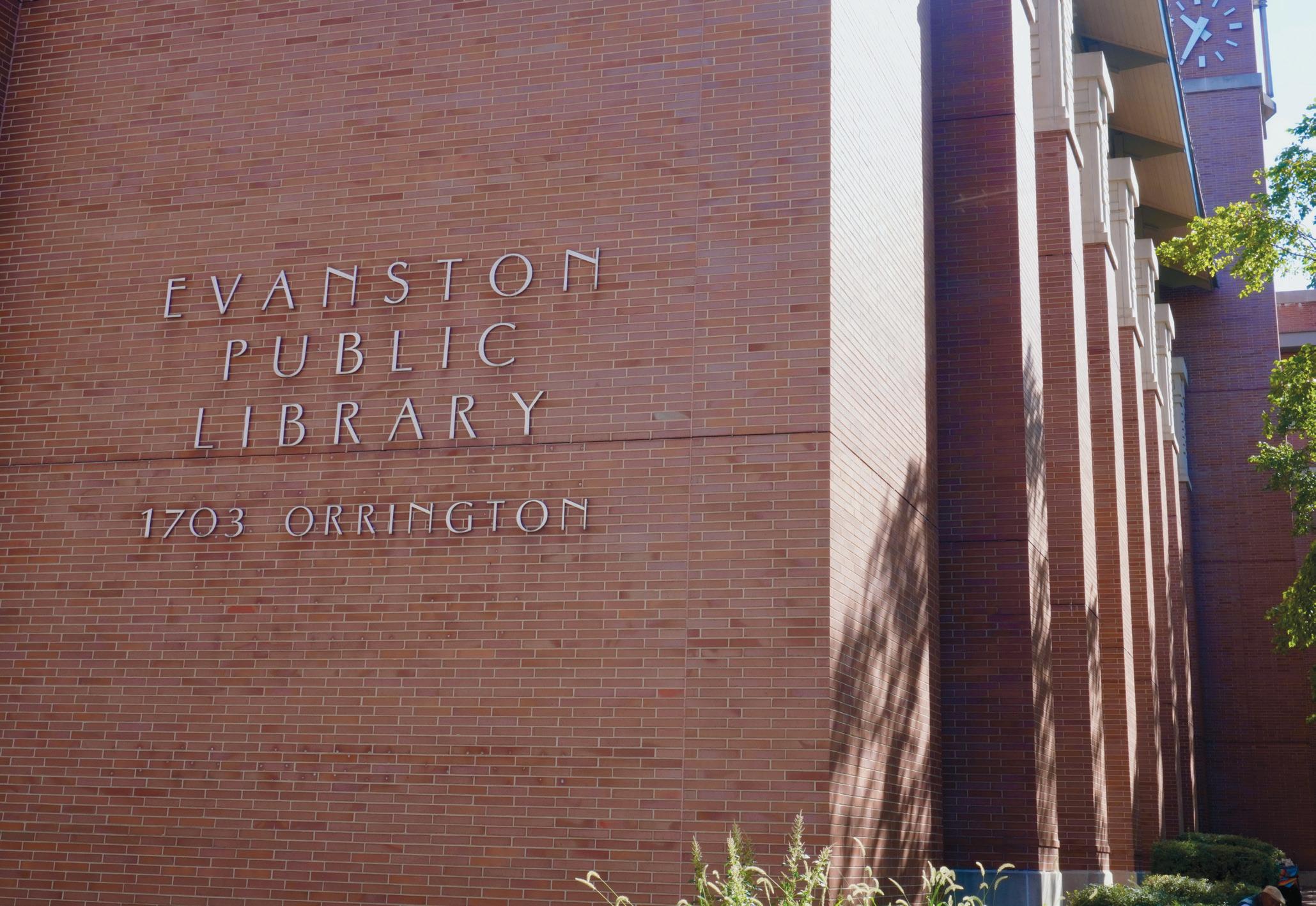
Public library weighs split with city Financial considerations and labor protections dominate discussion
By YONG-YU HUANG daily senior staffer @yong_yuhuang
On a quiet Sunday a ernoon,
families with strollers and Northwestern students in purple sweatshirts ltered through the doors of Evanston Public Library’s main branch at 1703 Orrington Ave.
NU to fund research through 2025
Bienen promises ‘essential funding needs’ to sustain ongoing work
By MELODY XU daily senior staffer
Interim President Henry Bienen promised the Northwestern community on Tuesday that “essential funding needs” will continue through the end of the year for faculty researchers impacted by the University’s $790 million federal funding freeze in April.
A week after the freeze, the University announced its commitment to continuing funding research affected by around 100 stop-work orders until the future of NU’s federal funding became more clear. Throughout this, researchers have been forced to adapt to symptoms of the Trump administration’s decision — a hiring freeze struck in June and more than 400 staff positions eliminated at the end of July.
“We continue to urge fiscal responsibility, including the conservative use of funds to help minimize University risk and extend the time that Northwestern can support our

research community,” Bienen and Peter Barris, Board of Trustees chair, wrote in a statement.
According to the statement, NU and its Board of Trustees had been committed for months to sustaining “critical research” despite the federal actions, and they reaffirmed this commitment at the most recent Board meeting.
The University will continue its efforts to regain the federal funding that was promised to its investigators, the statement read.
NU is “working diligently” to support faculty, postdocs, staff and students who drive its global impact, according to the statement.
“These efforts are grounded in core principles we share as an intellectual community: the preservation of academic freedom and the independent operation of our University,” Bienen and Barris wrote.
“These values are essential to our ability to pursue truth and address the world’s most complex challenges.”
m.xu@dailynorthwestern.com
From behind the stacks, a debate over EPL spilled into public view. In August, members of AFSCME Local 1891, the city employees’ union that includes library sta , protested against
the library’s potential break from city oversight. As EPL weighs becoming an independent library district,
» See LIBRARY, page 11
Council overrides grocery tax veto

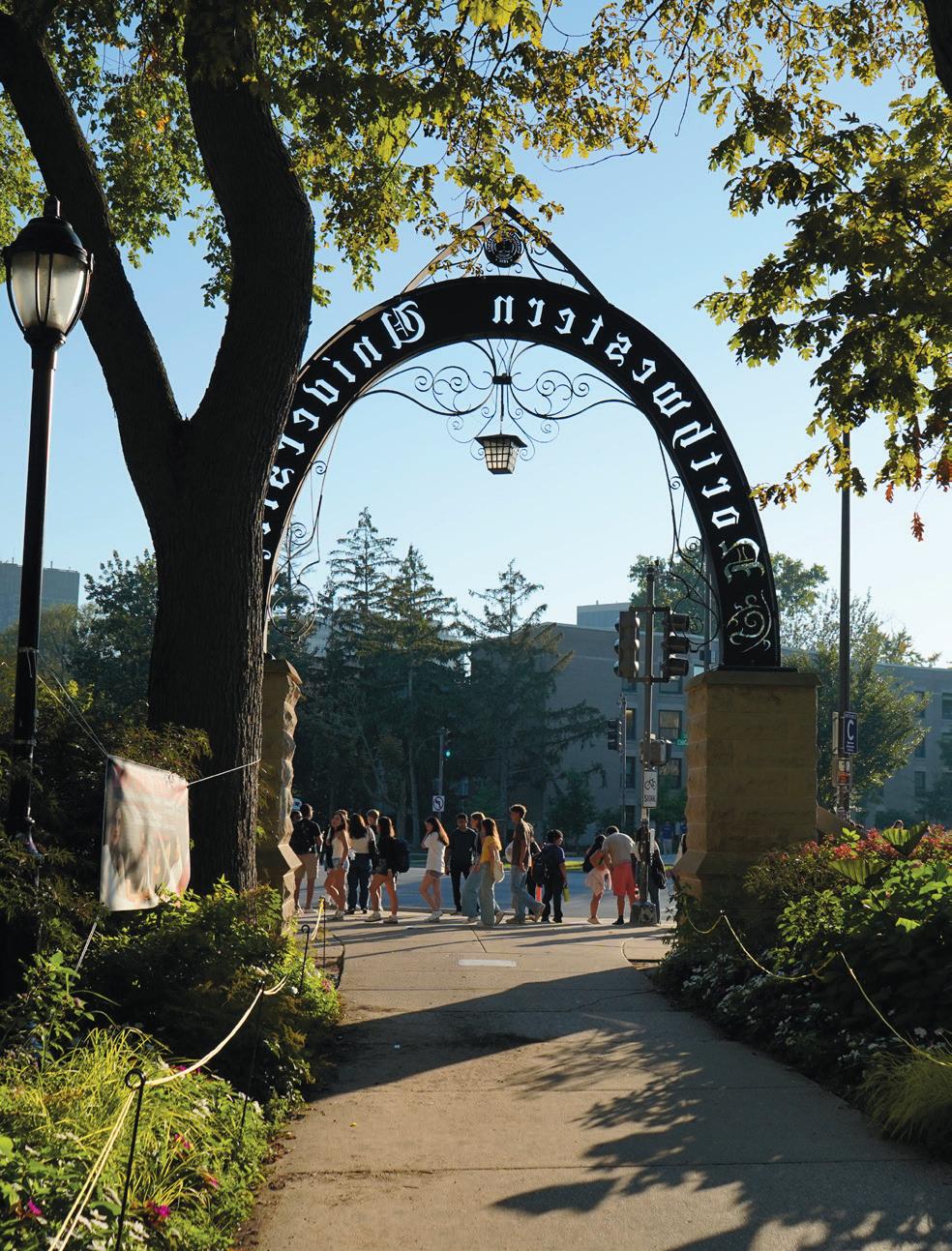
By RUBY DOWLING the daily northwestern @rubywright0
City Council gathered a supermajority Monday evening to override a mayoral veto of the 1% municipal grocery tax. The meeting was the final opportunity to finalize the ordinance before the state’s Oct. 1 deadline for the implementation of local grocery taxes.
The council members voted 8-0 in favor of overturning Mayor Daniel Biss’ Sept. 17 decision to veto the ordinance. To override, the council needed a two-thirds majority or six votes. Biss’ veto came after the council already passed the tax with a 5-3 vote Sept 15.
Illinois currently has a statewide 1% grocery tax, which will expire at the start of the new year. That state tax currently brings in $2.5 million in
revenue for Evanston. Just like the state tax, SNAP beneficiaries will be exempt from the new local tax.
The decision came swiftly and without deliberation. Alds. Clare Kelly (1st) and Matt Rodgers (8th), who voted against the tax in the original 5-3 vote, expressed concern but showed a grudging preference for the ordinance over alternative ways to gather funds.
City staff had also proposed raising property taxes as a suitable alternative to the 1% local grocery tax in order to replace the funds the city would bring in annually from the state tax.
“My concern at this point is damage control,” Kelly said.
The third councilmember who had previously opposed the tax, Ald. Parielle Davis (7th), left the meeting during public comment and was not present for the vote.
Ald. Jonathan Nieuwsma (4th) reaffirmed his support for the tax, citing a “nonscientific poll” he conducted, which he said found that two-thirds
AROUND TOWN
D65 school board talks consolidation scenarios
By SIDDARTH SIVARAMAN daily senior staffer @sidvaraman
Evanston/Skokie School District 65 sta released their initial school closure and consolidation scenarios amid signi cant community anxiety at a Monday night board meeting.
A er teachers, parents and sta across the district raised numerous concerns about school closures during public comment, board members spent most of their discussion time searching for an elusive Goldilocks zone. e board aims to save enough money by closing schools to preserve valued programs while not closing too many schools and overburdening the rest of the district, said Stacy Beardsley, assistant superintendent of performance management and accountability.
“ is is our one shot to get this right,” board member Andrew Wymer said. “I don’t think we can come back to the community in two or three years and say we didn’t right-size.”
e board se led on closing three schools starting in the 2026-27 school year, but it didn’t agree on which three to close. It asked district sta for a new model showing the impact of closing Lincolnwood Elementary School and Kingsley Elementary School while converting the K-5 section of the Dr. Martin Luther King Jr. Literary and Fine Arts School into a neighborhood school to potentially reduce the impact of closing a third school nearby.
District sta recommended closing Lincolnwood and Kingsley in four of the ve multi-school closure scenarios they presented because both would contribute a small number of students to other schools within walking distance.
Monday night marked the latest chapter in Phase 3 of the district’s Structural De cit Reduction Plan, which aims to secure long-term nancial stability by ne ing a target $10 to 15 million in cuts, right-sizing the district to ll classrooms as enrollment declines and addressing outdated facilities across the district. e board’s assessments about the decision ranged from “di cult” to “very, very di cult” to “di cult and painful” to “extremely di cult,” but none ventured to say it was impossible.
District 65 Chief Financial Officer Tamara
Mitchell said Phase 3 began with the formation of subcommi ees composed of around 60 parents, sta and community members. ey acted as “thought partners” with district sta , and the Facilities Commi ee created and weighted ve categories to consider for school closures in June, she said.
Mitchell emphasized that subcommi ees did not drive district sta ’s recommendations to the board. District sta evaluated scenarios involving the closures of zero to four schools. Decisions on which schools to close were based on the weighted categories — geography, equity, building cost, building functionality and building income — on a one-to- ve scale, with the lowest scores suggesting minimal impact.
Board member Maria Opdycke noted that projections scenarios were only based on enrollment projections until 2030. She said she felt uncertain about making sweeping changes without knowing their long-term impact.
She added that some of the recommended scenarios would create imbalances in utilization rate, which measures enrollment as a percentage of a school’s capacity. Some schools would still be underutilized, while others would be overutilized as they took on students from closed schools, she said.
Beardsley said balancing those utilization rates would increase district transportation costs. It would also force more students to cross large roadways and place some students more than 1.5 miles from their school, requiring the district to bus them to school, she added.
Wymer said he was not willing to change the weighting or criteria determined in earlier meetings while making closure decisions.
“I think we have to stay consistent and just own that it re ects a certain degree of community will, as well as administrative leadership that brought it to us,” he said. “We have to work within that frame.”
During discussion, Board Vice President Nichole Pinkard suggested closing Dewey Elementary School, adding that the district could convert the K-5 grades in King Arts to a neighborhood school that would accept the former school’s students.
Initial projections re ected King Arts’ status as a choice-based magnet school, but the board’s requested model includes Pinkard’s suggestion.
“If you model King Arts as a (K-5) neighborhood
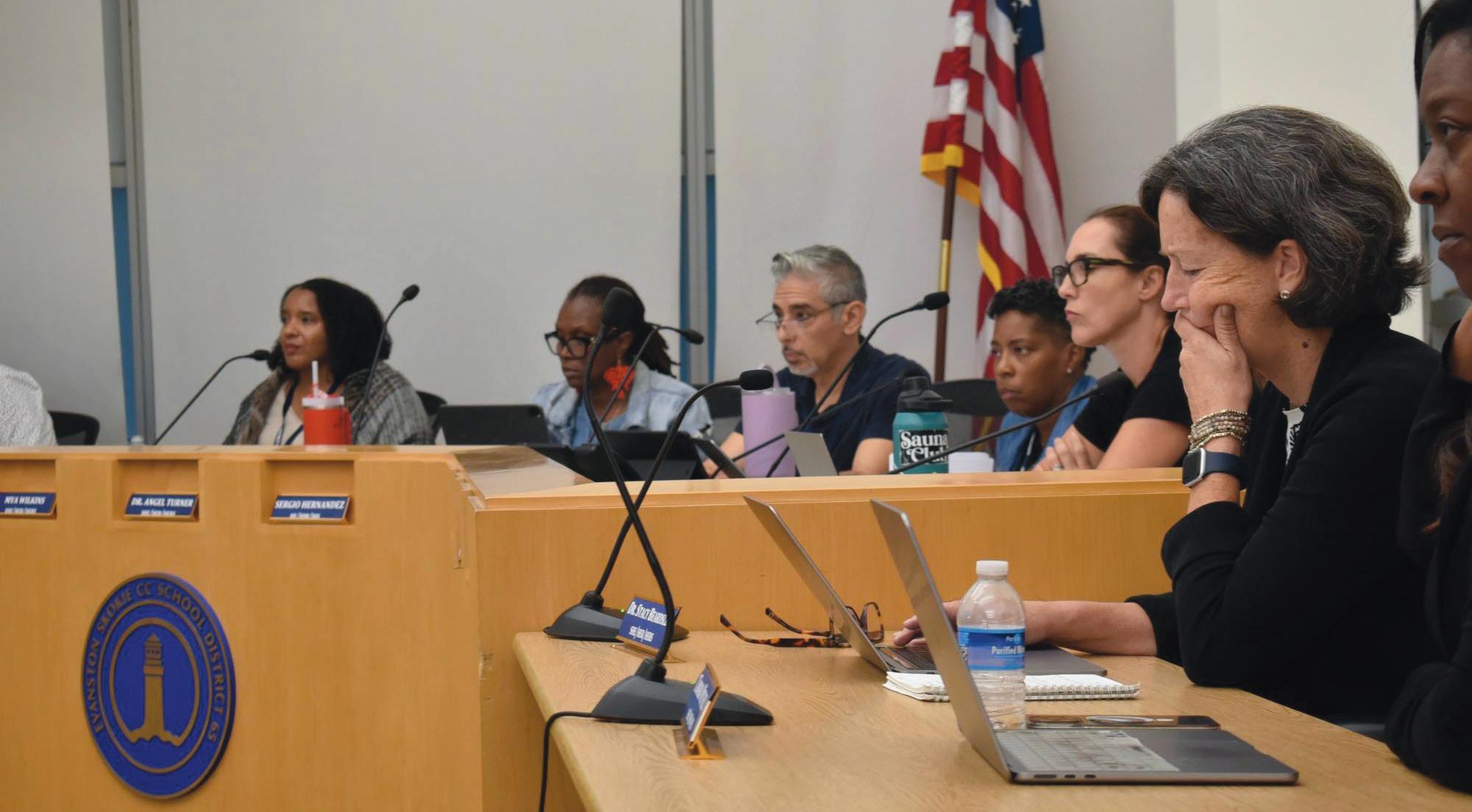
school, Dewey becomes plausible,” Pinkard said. “Without it, Dewey cannot close because it captures the entire middle.”
Even in district sta ’s best-case four-school closure scenario, the district would still need to cut around $1 million in programming and sta ng to meet its target of $11.8 million in savings, according to district sta ’s presentation to the board.
Student Programming commi ee member Terri Shepard said the number of people on her commi ee dropped from approximately 24 initially to around seven due to the “grueling” hours spent on the project. Her job was to evaluate extracurricular activities such as programming at the McGaw YMCA or the Books & Breakfast program, in which NU students and community volunteers provide breakfast and homework assistance to District 65 students, she said.
“We know how much many of you need these services, but as honest as I can be, the funds are lacking to continue programming as we have in the past,” she said in a presentation to the board.
Evanston resident Meghan omas criticized the board for not consulting teachers and sta in their
decision making. She questioned how reallocating sta to new schools would a ect student outcomes and said she didn’t trust the board to make scally responsible decisions.
She implored the district to slow down the SDRP process and include more teacher input.
At previous community engagement points in the SDRP process, the district has engaged sta for feedback. According to the district’s website, there were no sta engagement sessions over the summer, when the district released its criteria for evaluating schools. e district will review updated scenarios at its next board meeting Oct. 27 a er collecting community feedback in four sessions across the district Oct. 14 to 16.
“Making these decisions too quickly without input from all stakeholders, like your employees, can lead to catastrophic outcomes for students,” omas told the board. “I keep hearing you say you’re putting students at the center of these decisions. I see no evidence of that in any of the things that you have shared.”
s.sivaraman@dailynorthwestern.com
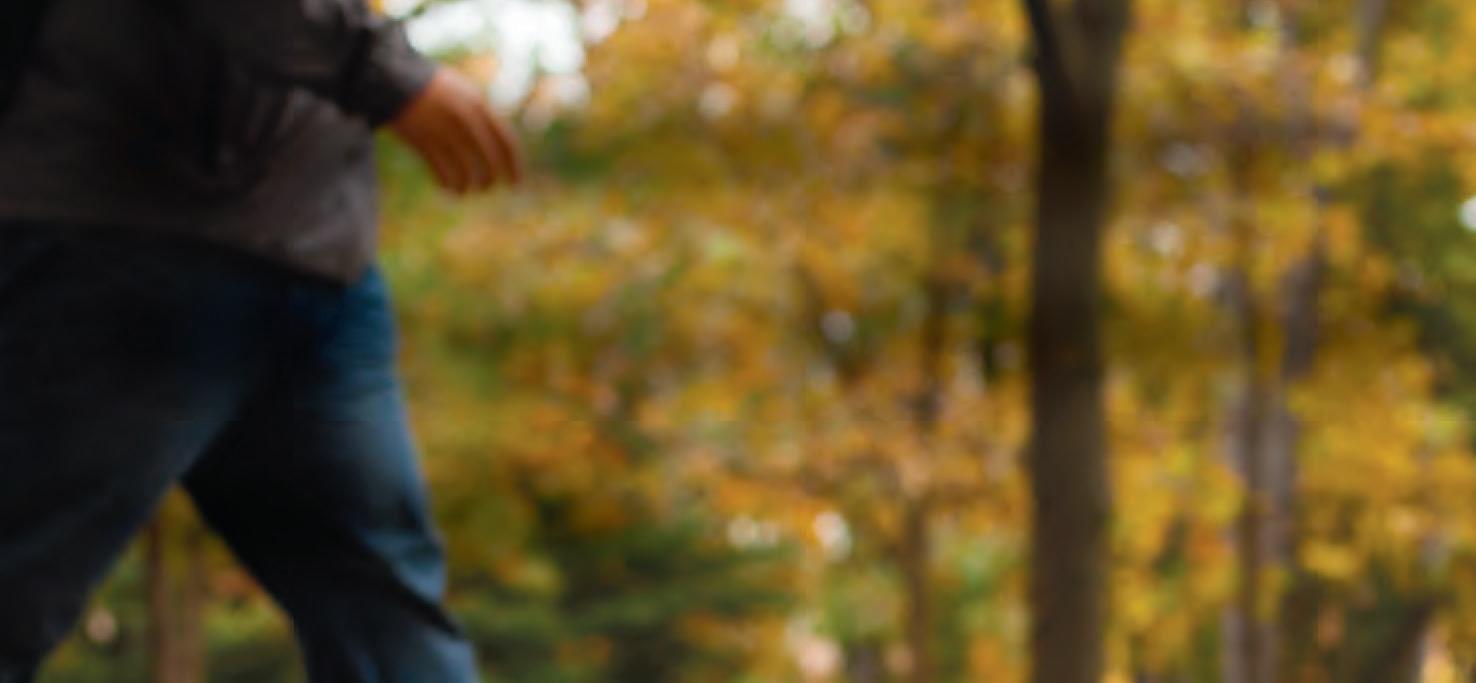
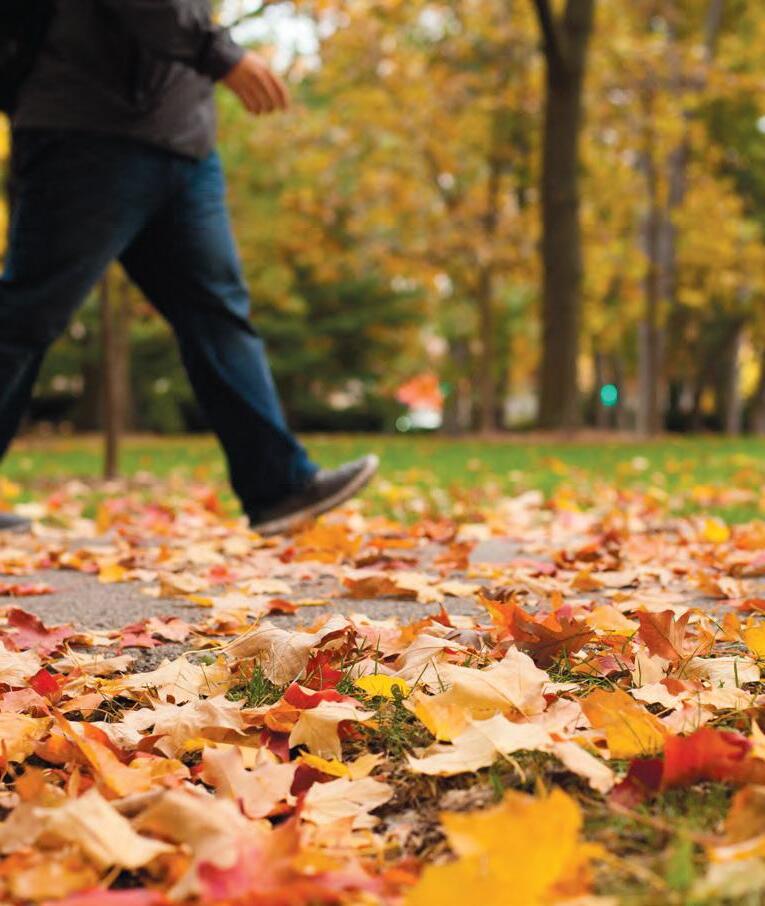

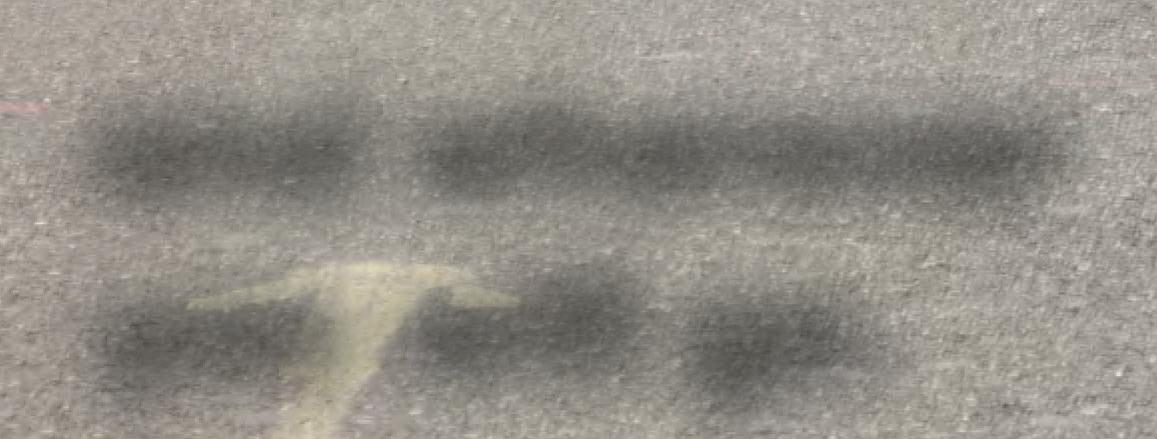
H-1B visa fee prompts campus concern
By SIDDARTH SIVARAMAN and CAYLA LABGOLD-CARROLL daily senior staffers @sidvaraman / @caylalc
When Spanish and Portuguese Prof. Jorge Coronado was a department chair in the early 2010s, he never wondered if the international faculty he hired would get a visa.
Once departments had selected the best candidate for the job, they let Northwestern’s Office of International Student and Scholar Services handle the applicant’s paperwork, Coronado said. Fees for an H-1B visa, reserved for highly specialized workers like world-renowned professors, typically ranged from $1,700 to $4,500, but he said he always expected NU to cover the cost.
“It was to such a point that we just didn’t think about it,” Coronado said. “It wasn’t like they were saying, ‘Hey, what does this person get, a J-1 or an H-1B?’ Nobody would ask you that.”
On Sept. 19, the Trump administration issued a presidential proclamation adding a new $100,000 fee, on top of the existing fees, to petitions for new H-1B visas. Today, NU department chairs find themselves reckoning with the new visa petition fee on top of an existing hiring freeze.
While students worried about their international peers’ chances of securing a worker visa after graduation, faculty wondered aloud about how the H-1B fee would impact the University’s standing in the global research community.
In 2025, USCIS approved 84 new employee H-1B visas and 51 renewals for NU, according to the department’s data. These numbers mirror previous years since 2017.
Fifth-year musicology Ph.D. candidate Kristian Rodriguez, who is also the Bienen School of Music divisional chief steward for the NU Graduate Workers union, said many of their peers have given up on working in the U.S. after finishing their graduate programs.
Rodriguez predicted that visa restrictions like the H-1B fee will narrow application pools as international candidates look for positions outside the U.S.
“That is going to have a significant impact on the quality and vibrancy of our workforce at
Northwestern,” they said. “It depends on skilled labor from outside the United States at all levels — undergraduate, graduate, postdoc, faculty and so forth.”
According to Inside Higher Ed, U.S. universities employed more than 16,000 international workers on approved H-1B visas, making up about 5% of the total approved H-1B visas for the 2025 fiscal year.
A Ph.D. candidate who requested to remain anonymous because they are actively searching for a job said they are aiming for a research and development position at a private company in the U.S., which would likely require an H-1B visa.
They said some research labs lack job security because of funding concerns. If they got laid off from an underfunded lab, they said, they would lose their H-1B status.
Other private companies are restricting job applications to U.S. citizens or green card holders because of federal funding issues, they added. Still, despite advice from mentors in the industry to leave the country and return when they have more experience, they continue to search for a position in the U.S.
“I made some very good friends here in the U.S., either with other international students or domestic students, so I do have some bonds here,” they said. “If I leave the U.S., I won’t be able to see some of my friends for several years.”
Ian Wagreich, an immigration lawyer who helps universities manage student and temporary work visas, said the presidential proclamation initially appeared to apply to people who already had H-1B visas.
Employers across the country panicked, he said, thinking that H-1B visa holders abroad had to return to the U.S. before the proclamation took effect.
After the proclamation, the NU Office of International Student and Scholar Services issued a statement advising H-1B visa workers that were out of the country to return to the U.S. by the time the proclamation was set to take effect Sept. 21.
The White House later clarified that the fee would only apply to new visa applications, not to current holders or renewals. The next day, the University updated their statement calling attention to
the White House’s clarification, but did not retract their original advice to return to the U.S.
Wagreich said it remains to be seen how the “broadly written” proclamation will be interpreted down the line. He added that it may not apply to international students currently enrolled in U.S. universities.
“That’s what it appears today,” Wagreich said. “Who knows if it’ll be the same tomorrow?”
The Ph.D. candidate who requested to remain anonymous said they hope the new fee will not apply to U.S.-based students like them. They are waiting to finish their program at NU until they secure a job offer because they need to maintain status in order to avoid the fee, they added.
Wagreich said it’s unclear if employers will only have to pay the fee once or if it will apply to every petition they file. Whatever the specifics, he said the policy is likely to make H-1B visas too expensive for smaller employers, including universities.
Wagreich added that he expects higher education associations or healthcare providers in underserved areas to file suit against the proclamation.
The new fee comes after the University announced a faculty and staff hiring freeze in June — just one of a litany of cost-cutting measures taken by the University in recent months. Weinberg Prof. Kevin Boyle, who serves as a history department chair, said it was unclear how the H-1B fee would affect recruitment if the hiring freeze was lifted.
Now the director of Weinberg’s Andean Cultures and Histories working group, Coronado said that the federal government’s new policies have heightened anxieties for his international colleagues, causing many to turn down collaborations or positions with American universities.
He said exchanging ideas and engaging with professors from other countries has provided tremendous value to his classrooms in over 20 years at NU.
“My closest colleagues in Latin American and Caribbean Studies, I mean, some of them were born here, but many of them were born somewhere else,” Coronado said. “I’m talking about brilliant faculty. What would it mean for them to not be able to be here and teach students?”
s.sivaraman@dailynorthwestern.com c.labgold-carroll@dailynorthwestern.com
The Daily Northwestern www.dailynorthwestern.com
Editor in Chief Emily Lichty eic@dailynorthwestern.com
General Manager Stacia Campbell stacia@dailynorthwestern.com
Holly and John Madigan Newsroom
Phone | 847.491.3222
Campus Desk campus@dailynorthwestern.com
City Desk city@dailynorthwestern.com
Sports Desk sports@dailynorthwestern.com
Ad Office | 847.491.7206 spc-compshop@northwestern.edu
The Daily Northwestern is printed each Wednesday during the academic year, except vacation periods, the two weeks preceding them and once during August, by Students Publishing Co., Inc. of Northwestern University, 1999 Campus Drive, Evanston, IL 60208. All news is published 24/7 online at Dailynorthwestern.com.
First copy of The Daily is free, additional copies are 50 cents. All material published herein, except advertising or where indicated otherwise, is Copyright 2025 The Daily Northwestern and protected under the “work made for hire” and “periodical publication” clauses of copyright law.
POSTMASTER: Send address changes to The Daily Northwestern, 1999 Campus Drive, Evanston, IL 60208. Subscriptions are $100 for the academic year. The Daily Northwestern is not responsible for more than one incorrect ad insertion.
Check out DAILYNORTHWESTERN.COM for breaking news
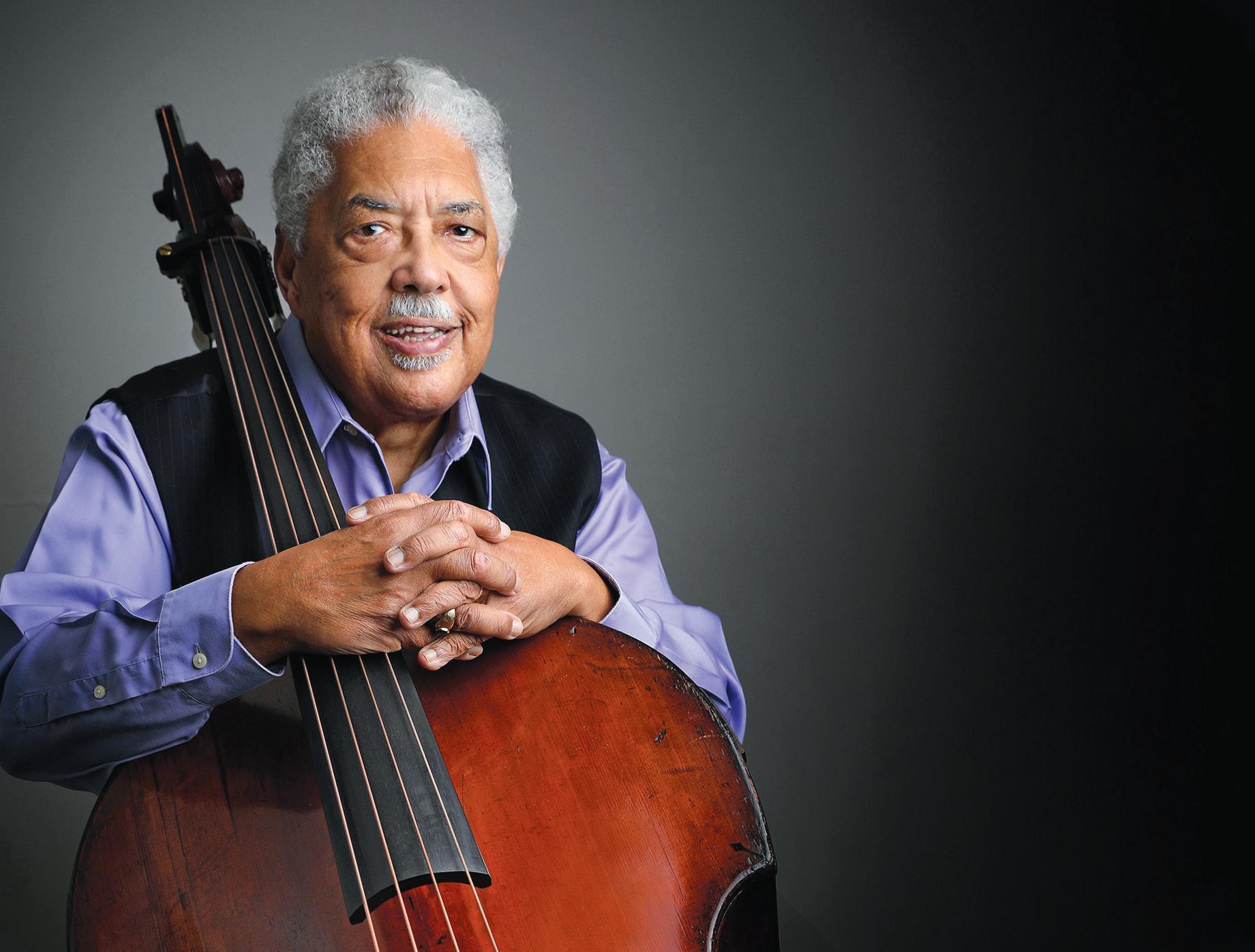
















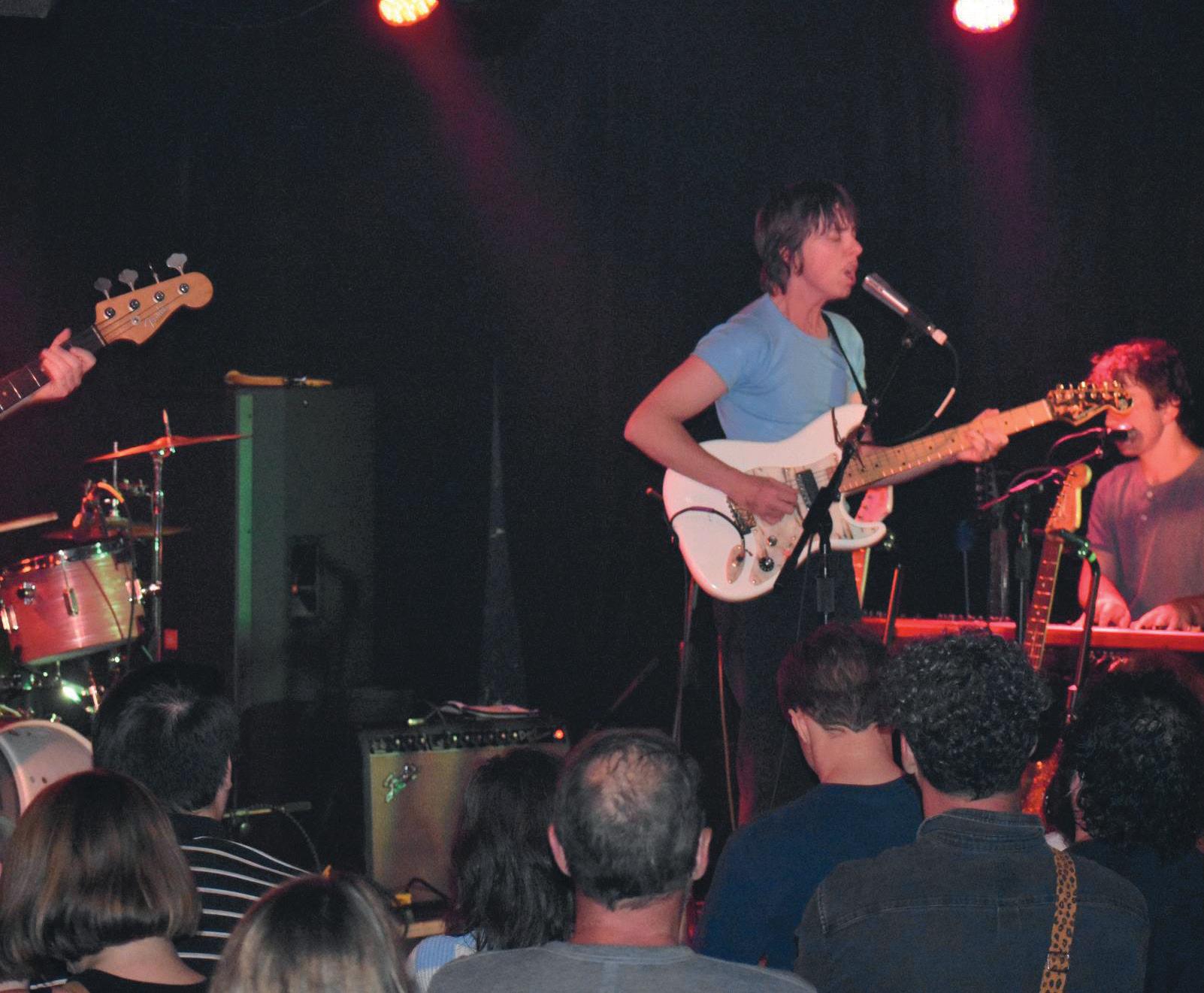



Band Hand Habits brings stellar energy to intimate venue
By CLARA MARTINEZ daily senior staffer
@claramart1nez7
Hand Habits, a band blending indie rock and folk, played at the Empty Bo le in Chicago’s Ukrainian Village neighborhood Sunday night. Fashion Club opened for the band, playing tracks from her second solo album “A Love You Cannot Shake.” Under the moniker Fashion Club, Los Angeles-based artist Pascal Stevenson experiments with synth e ects to bring a distinct sound to each track.
e Empty Bo le’s intimate venue has a capacity of 400 and a endees pass through a game room — decked out with a retro photo booth and pool table — to get to the dimly-lit dive bar and stage. Posters calling back to a ’90s style paper the walls. A
fog machine in the corner created an otherworldly sense of calm in the still moments before the band took the stage.
Hand Habits is songwriter and instrumentalist
Meg Du y’s solo project. e band played a few tracks from their latest album, “Blue Reminder,” along with songs from their previous albums “placeholder” and “what lovers do.”
Du y leads the quartet as the singer and guitarist, supported by bass, drums and piano. Backed by ethereal piano interludes and shoegazey guitar, Hand Habits is a sonic expression of yearning.
Moving between so er ballads that lean on poignant lyrics and piano melodies to rock-driven tracks with piercing ri s, Hand Habits demonstrated their range across years of discography.
e band opened the concert with pulse and energy, kicking o the set with songs like “Bluebird of Happiness” and “Wheel of Change.” e
consistent drum beat created a vibration that layered against Du y’s intricate guitar ri s.
A er playing a few songs, Du y said that the night before, their concert in Detroit had been cancelled because the venue didn’t sell enough tickets. ey held up the “rock on” hand sign, joking about the irony of losing a crowd in “Detroit Rock City.” Yet, they said Hand Habits played anyway at a nearby mansion.
Du y’s banter in between songs had everyone laughing, even though every song kept the crowd’s full a ention with the longing infused into Du y’s vocals.
When talking about their music video for “Wheel of Change,” which features Du y walking around suburbs and urban areas, Du y said they had to explain to their family that there was no deeper meaning behind it.
“Isn’t that just like every music video ever?” they
said. “ ere’s no signi cance.”
About halfway through, the lights shifted from red to blue tones. Du y swapped guitars, exchanging a crunchy electric guitar sound for a so er reverb to create a more somber atmosphere. Instead of nodding along to the beat, the crowd began to sway to the raw lyrics of “what lovers do” and “4th of july.”
Toward the end of the set, Du y’s deadpan jokes continued, keeping up the crowd’s energy even between songs. Before playing the penultimate song, “Aquamarine,” they said there were certain changes they hoped to see in the world.
“My trans agenda,” Du y said, “is converting every lesbian in their mid-30s into a fan of the Grateful Dead.”
claramartinez2028@u.northwestern.edu
Cross-Rhodes spices up Evanston with new Mediterranean fl
By RACHEL SCHLUETER and KUNJAL BASTOLA
daily senior staffers
@rschlueter26
/ @kunjal_bastola
ere’s an unspoken checklist for great hole-inthe-wall dining: an unassuming exterior, a small but mighty wait sta and a cash-only policy.
In Evanston, most restaurants check o one, maybe two. But it’s rare to nd all three — except at Cross-Rhodes, where authentic, cheap Greek fare is served in mountainous portions.
You’ve likely sped past Cross-Rhodes countless times. Located at 913 Chicago Ave., the restaurant sits on the lower level of a red-brick, stand-alone building. It’s located one block from the Main
Street CTA stop and the Intercampus Shu le Chicago/Main stop.
Je Russell opened Cross-Rhodes in 1984 shortly a er marrying his wife, Georgia, in Kalamata, Greece. Cross-Rhodes has been familyowned ever since, and its quaint, welcoming interior makes both newcomers and regulars feel instantly at home.
Cross-Rhodes is cash-only, but has an ATM inside. e restaurant’s open-air kitchen features large vertical rotisseries that spin with cones of lamb and beef, lling the dining room with an earthy aroma. On a recent Wednesday night, customers lled the restaurant’s handful of square wooden table tops. We started o with an order of tyroka eri: a
tangy, thick feta cheese dip with spicy roasted red peppers. e dish came with a side of pita, which had a crisp crust and pillowy interior.
We also tried the spanakopita, a classic Greek pie consisting of spinach and cheese. e aky crust paired with the so lling was just the right ratio of spinach to cheese. Along with a li le dollop of tzatziki sauce, each bite was delectable.
e Cross-Rhodes menu boasts a variety of authentic Mediterranean entrees, including mousaka, a layered eggplant and beef casserole and pastitsio, a Greek-style lasagna with tomato, cheese and an egg custard topping.
Cross-Rhodes also has a variety of sandwiches and pitas that require a strong two-handed grip (and at least ten napkins). You’ll probably get
tzatziki all over your shirt, but it’s totally worth it.
e pita sandwiches come with your choice of meat (beef and lamb, pork or chicken), tomato, onion and feta cheese.
We tried the country pork souvlaki pita, which was roasted to a tender perfection and burst with lemon and garlic avors. Each pita is also topped with a few salted french fries and tzatziki, which added a fresh touch of dill and mint.
If you’re looking for an a ordable but hearty dinner that is sure to make you want to come back, look no further than Cross-Rhodes.
r.schlueter@dailynorthwestern.com kunjalbastola2026@u.northwestern.edu
Doja Cat’s ‘Vie’ gives new life to classic ‘80s retro
By TROIS FRANCOISE ONO daily senior staffer @troisono
When I think of Doja Cat, I picture her in her now-iconic outfit from the SS23 Schiaparelli Haute Couture fashion show, covered head-totoe in 30,000 red crystals.
Although she’s widely known for her feud with actor Noah Schnapp and unexpected jabs at her own fans, Doja Cat’s talent may outweigh all other traits. Her recent album release, “Vie” (meaning ‘life’ in French), might just make skeptics want to separate art from artist.
Compared to the angsty edge of 2023’s “Scarlet,” “Vie” feels looser and more playful. A sonic smoothie of ’70s and ’80s influences, Doja Cat raps atop of radio and synth wave beats, paying homage to ’80s trailblazers like Prince and Grace Jones.
The album’s pre-release promotion leaned heavily on retro iconography, and “Vie” itself layers in samples from vintage TV and stardom.
The album opener, “Cards,” sets the stage with a smooth saxophone line that immediately signals the album’s retro flair. Doja Cat lets out a drawn-out shriek before the beat kicks in, a dramatic entry that pulls listeners directly into her world of “Vie.”
On “Jealous Type,” which was co-produced with Jack Antonoff and Y2K, Doja Cat leans into R&B warmth with Donna Allen-inspired tones, ending the track with an impressive belt.
The most infectious track is “AAAHH MEN!”, a cheeky play on the word “amen.” Built on an
upbeat groove with a hint of Michael Jackson, the track layers crisp percussion and synth stabs under Doja Cat’s elastic vocals. Its energy is contagious — It’s the kind of song that’s destined to become a crowd favorite.
“Gorgeous,” although a little bland in comparison to the other tracks, gets points for its creative music video. Featuring top models like Anok Yai, Doja Cat blends the contemporary art forms of high fashion and makeup with the tension of beauty standards. A highlight of the song was the personal touch of a voice message from her mother, which Doja Cat included in the interlude.
“One More Time” transports listeners to a retro aerobics studio. The layered shouts, synths and plucky guitar make this song a perfect addition to the album, encapsulating ’80s fun.
As “Vie” is a romance-centered album, Doja Cat also balances the ups and downs of relationships, drawing on her past experiences and newfound revelations through therapy. We see a softer, more emotional side to Doja Cat in “Happy.” French lyrics add tenderness to her bittersweet and vulnerable reflections on heartbreak.
“Come Back” is the closing song of “Vie.” The subtle lyric “don’t you come back” at the end creates a powerful turnaround. As the last word of a 15-track journey through romance, conflict and self-reflection, “Come Back” ties the album together by leaving listeners in a state of quiet resolve.
It’s safe to say that there isn’t a single song to be completely disliked on this album. However, not every track shines. Songs like “Couples

new
is a sonic
of ’80s R&B and pop influences.
Therapy,” “Lipstain” and “Silly! Fun!” offer very little vocally or sonically.
The album art, too, oddly clashes with the sonic flavor of the album. Neither the digital nor the physical covers exude the ’80s retro aura that Doja Cat played around with so beautifully. Symbolically, it does match the tone of the album, but it is visually mismatched.
Still, “Vie” is a quintessential pop record with
major appeal to the masses. The downside of this is a loss of Doja Cat’s eccentric personality — but putting that aside, “Vie” could make a strong contender against the artists’ 2021 hit “Planet Her.” There is no doubt this album is a success, and it won’t be long before its hooks dominate TikTok.
troisono2028@u.northwestern.edu
Despite minimal promotion, ‘Twinless’ offers profound message
By DALTON HANNA daily senior staffer @daltonhanna06
I walked into the movie theater to see “Twinless” completely blind. In a world where marketing is shoved upon you, it felt rare to stumble upon a movie that I hadn’t seen a single trailer for. But with “Twinless,” I wouldn’t have wanted to watch it any other way.
Before continuing this article, I recommend stopping here and watching “Twinless” just as I did: without any prior knowledge. It was what really made it so, so good.
“Twinless” cannot fit into a single genre or style. It’s fresh, uncomfortable at times and incredibly genuine. At its core, it is a story of loss that tackles the concept of sibling connection.
Roman (Dylan O’Brien) is trying to cope with the death of his twin, Rocky (also O’Brien), who
died in a car accident. At a twin loss support group, he meets Dennis (James Sweeney), and the two quickly form an intense co-dependent friendship in the absence of their twins.
Thirty minutes into the film, after a late title screen rolls, the viewers learn that Dennis is, in fact, not a twin, but rather was romantically involved and obsessed with Rocky, accidentally causing the car accident that killed him. To deal with his grief and guilt, Dennis stalks and befriends Roman without revealing this information.
“Twinless” quickly takes a turn for the twisted. As an audience member, it’s incredibly anxiety-inducing and stressful to watch Dennis fall further into this lie as he shares more heartfelt moments with Roman.
At the movie’s climax, Dennis’ anxiety feels as if it bleeds into the cinematography, which it likely does, since Sweeney is also the writer and director of the film.
However, the movie isn’t purely stressful; it’s also laugh-out-loud hilarious. O’Brien seamlessly
masters two very different characters: straight, gullible, macho-boy Roman and sarcastic, witty, homosexual Rocky. But while I found myself laughing more at “Twinless” than most movies in the past few years, it wasn’t a straight comedy either.
The writing and connection between Dennis and Roman is formed so perfectly that it encapsulates a sibling bond. It is beautiful and devastating to see this relationship build out of loss and then crumble when Roman realizes their shared trauma wasn’t real.
“Twinless” ends with Roman and Dennis reuniting at a diner, the first place they went together. It is a beautiful parallel to the beginning of the movie that showcases the characters’ growth — especially as it highlights Roman’s journey through grief and managing the anger he’s channeled toward Dennis since discovering the truth.
The scene was raw as the two realized that the connection and friendship they shared was not and could not have been made up. Despite the messed-up
circumstances, the friendship between Dennis and Roman was real, and in that final moment, as they ask for a to-go box simultaneously like twins, they know that they will always be linked.
The relationships in “Twinless” explore a dynamic rarely seen on screen: twin brothers, one gay and the other straight. The film examines masculinity and the complexities of growing up as twins with different sexualities.
Roman, in particular, struggled with anger and insecurity after Rocky came out, questioning his own masculinity in the process. Through his connection with Dennis, however, Roman seems to have a shot at redemption, an opportunity to rebuild the bond with a twin that he never managed to sustain in adulthood.
“Twinless” is a jarring reminder that even in the midst of loss and lies, the bonds we form, however imperfect or twisted, can still be profoundly real.
d.hanna@dailynorthwestern.com
Reneé Rapp wows Chicago with ‘cheeky humor’ show
By NAVYA SINGH daily senior staffer @navyasingh332
Reneé Rapp wowed Allstate Arena on Thursday with powerful vocals, sultry choreography and cheeky humor during the Chicago stop of her “BITE ME TOUR.”
R&B artist and 2025 Dillo Day mainstage performer Ravyn Lenae opened the show. Just as she did at Dillo, Lenae shined with her unique voice and sincerity.
Before Rapp’s entrance onstage, screens broadcast a video of her encouraging the audience to donate to an organization helping struggling children around the world. In the video, Rapp also confirmed that she would be donating a portion of her merchandise proceeds to the charity, showing her philanthropic side.
The show started with a video titled “The Interrogation,” in which several characters, including a frazzled PR agent and deadbeat boyfriend (all
A Boogie Wit da Hoodie set to headline A&O Blowout next week
Rapper A Boogie Wit da Hoodie will perform at A&O Productions’ annual Blowout concert, A&O announced Tuesday. A Boogie will take to the stage at Welsh-Ryan Arena on Oct. 9 at 8 p.m., A&O said in an Instagram post. A Boogie is best known for his 2018 hits “Look Back at It” and “Swervin” off his second full-length album “Hoodie SZN,” which debuted at No. 2 on the Billboard 200. A native of The Bronx, A Boogie
played by Rapp), questioned Rapp before she exclaimed, “Leave me alone!”
The screen shattered as the video concluded, providing a perfect segue into Rapp’s first song, hit single “Leave Me Alone.” It was the perfect introduction to Rapp’s bold personality.
Rapp began the show singing atop a high platform on a tiered pink stage in the shape of a star, looking like every bit the diva she is. She then was lowered onto the stage for the next songs “Kiss It Kiss It” and “Talk Too Much.”
While the songs Rapp sang slowed down, the audience’s energy didn’t. “Poison Poison” had the crowd singing along to the song’s angry lyrics.
After that, Rapp got Allstate Arena grooving to songs “Shy,” “Mad” and “Why Is She Still Here?” Her belt remained impressively steady as she hit every note effortlessly.
Rapp also sent the audience into hysterics with her bold remarks throughout the show.
“You may call me tardy, hard to work with, sickeningly sexy, ahead of my time,” Rapp said, eliciting laughter from the crowd. “But you can
most recently released his critically-acclaimed album “Better Off Alone” in 2024. A&O organizes Blowout every Fall Quarter. Prior musicians to visit Welsh-Ryan include Rico Nasty in 2024 and Dayglow in 2023. This year, A Boogie will perform after rapper RHOME completes his opening set. For the first year, A&O is teaming up with Northwestern’s basketball teams to put together Blowout. NU’s Athletics’ Instagram marketed the concert as a “student preseason basketball event.” Blowout tickets will be available for students on the A&O Instagram page starting Friday at 12 p.m
— Maya Wong
never call me a bad friend.”
That quip was the introduction to her next song, “That’s So Funny” — a ballad she performed with her pianist alongside “Sometimes.” Rapp pumped up the tempo with “Good Girl” and “Swim.” For the latter, icy-blue LED lights helped convey the song’s alluring mood.
Throughout the show, Rapp extended some of the songs by adding another chorus, making the transitions between songs very smooth. She also wowed the audience with her sensual moves, including a moment with her guitarist. The camerawork was stellar, Rapp flirting with the camera even while her back was turned to the audience.
After, Rapp sat down for the emotional hits “I Think I Like You Better When You’re Gone” and “I Can’t Have You Around Me Anymore,” to which the audience waved their phone flashlights.
Rapp then launched into “Tummy Hurts,” “You’d Like That Wouldn’t You” and “Pretty Girls.”
Despite the songs’ contrasting vibes, the transition between the loud “BITE ME” concluder and the softer “Pretty Girls” felt jarring in a fun way and
arts & entertainment
Editor Maya Wong
Assistant Editors
Clare Kirwan
Clara Martinez
was well-received by the audience. Rapp then performed her 2022 ballad “In The Kitchen.” She said that when she wrote the song, she wasn’t sure if she would want to perform it live. However, three years after the song’s release, she said she loves it even more every time she performs it.
Although the audience sang along to every word, they stayed quiet for the next song, “Snow Angel.” The ballad, from her 2023 album of the same title, may have had the crowd silent — But everyone was no less spellbound as they allowed Rapp’s voice to echo in the arena.
At the end, Rapp teased the audience by playing “Not My Fault,” her original song from the 2024 Mean Girls remake, before stopping abruptly, saying she didn’t want to perform it. Needless to say, the audience was disappointed until she launched straight into “At Least I’m Hot,” ending the night on a high.
The stage was small, but Rapp’s star power lit up all sides of it for an unforgettable night.
n.singh@dailynorthwestern.com
design
Editors
Shun Graves
Matt Wasilewski
Assistant Editors
Lauren Kee
Diya Raj
Residents raise concerns on proposed bike lanes
By NAVYA SINGH daily senior staffer @navyasingh322
As Evanston continues to move forward with the Chicago Avenue Multimodal Corridor project, some members of the street’s community have concerns — particularly about the planned bike lanes.
The project received a $10.06 million grant in August from the U.S. Department of Transportation. Along with extending the bike lanes on Chicago Avenue from Davis Street to the Chicago city limits, the project aims to upgrade and improve the safety of bus stops, traffic signals and crosswalks. Construction is intended to start in 2028.
On Sept. 22, the Department of Transportation rescinded grants for bike lanes in several U.S. cities, including Boston and Fairfield, Alabama. An Evanston spokesperson confirmed in an email to The Daily that the city has not yet been notified of any “grant funds for transportation” being rescinded.
The study guiding the bike lane construction was conducted in 2020. The city hosted two public meetings in 2021 and one in 2024 to gauge feedback on the project.
Armen Minasian, owner of Minasian Rug Company on Chicago and Dempster, said that since the community meetings occurred during the COVID-19 pandemic, the city didn’t try hard to get local business perspectives, which he called “typical of Evanston politics.”
“This bike lane is running right through a very busy street with lots of long-existing businesses,” Heather Behm, the co-owner of Union Pizzeria and Union Squared, said. “So, I am concerned about the impact that it’s going to have on our business.”
She said that she relies on parking because the majority of her business is pick-ups or deliveries. Without storefront parking, drivers have to park a block and a half away, which is “an inconvenience” to them, Behn said.
While Behm said the city did the “proper thing” by putting a notice on the website, she wishes they had sought more direct conversations with businesses.
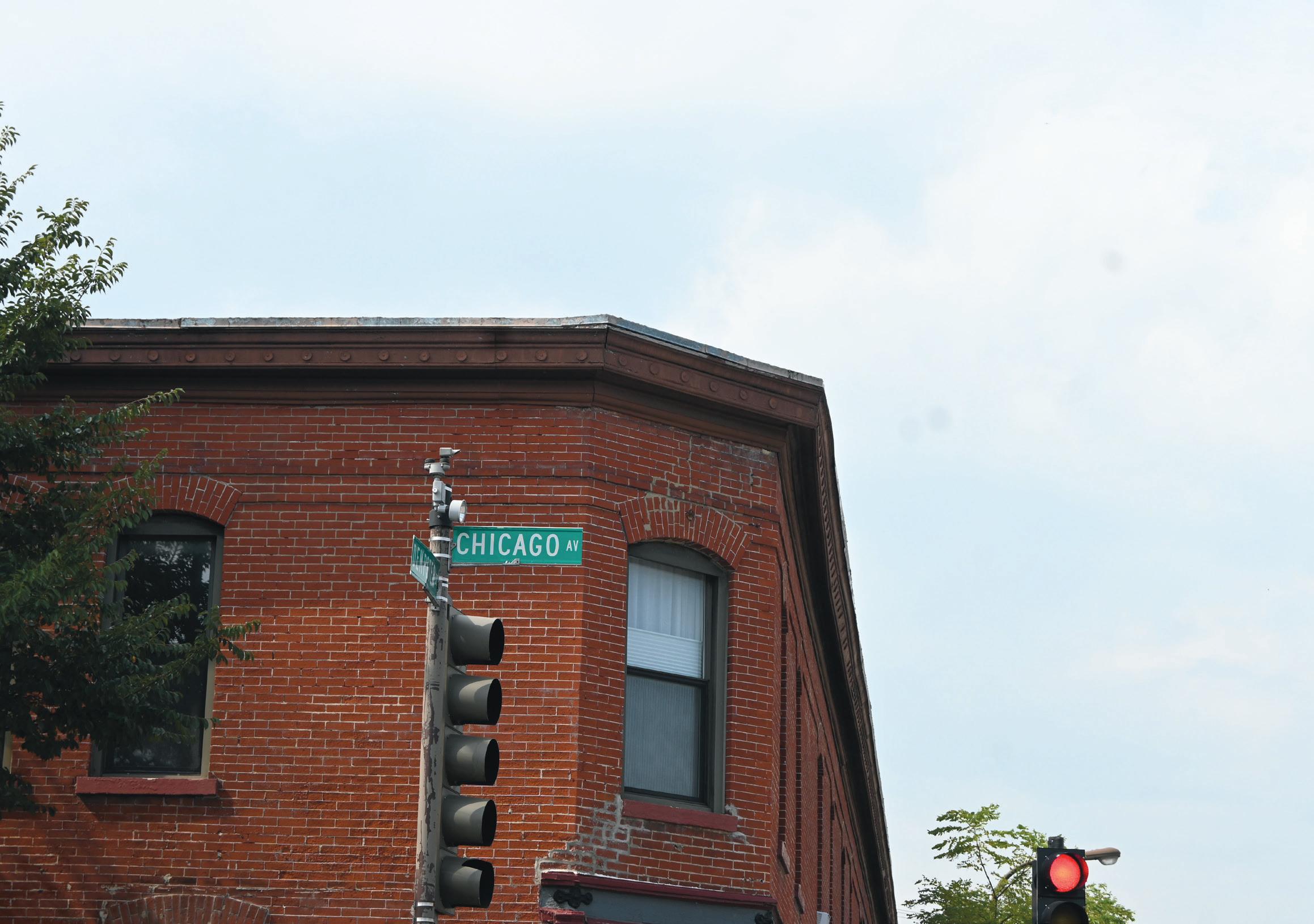
“We bring in thousands and thousands and thousands of dollars in revenue through liquor taxes,” she said. “We should have been directly engaged at the outset of this plan.”
For 3rd Ward resident Laura Kushner, the biggest issue is also parking. Although she didn’t attend any community meetings, her neighbors told her their questions about residential parking on Chicago Avenue were ignored.

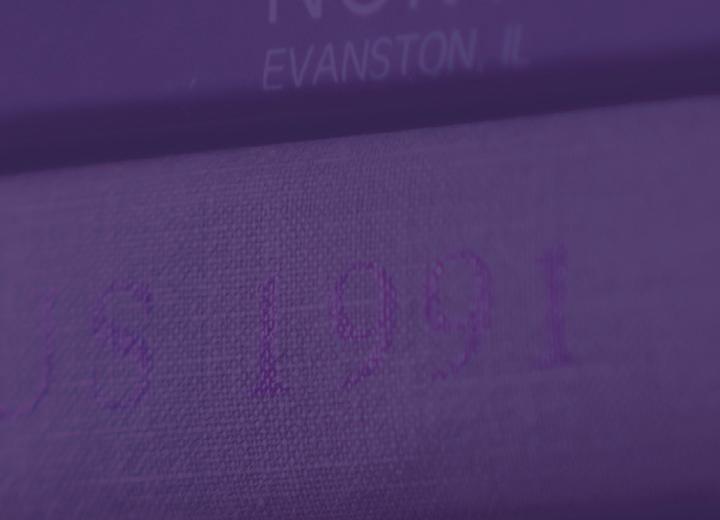
“We’re just worried that if we have service people come to our homes, where would these service people park?” she said.
Minasian said that he is also worried about the safety of drivers with the new bike lanes.
He said that from his shop, he sees emergency
Kushner said Southeast Evanston is densely populated, so finding a parking space in front of her townhouse complex, the Courts of Evanston, is already tricky. It will only become harder when the new South Boulevard apartment complex is completed, she said.


vehicles traveling down the
Typically, cars pull over to make
at
for these vehicles. When the bike lanes are completed, they will have less room to do so,
“I don’t have a problem with the bike lane, but I do have a problem with doing something that’s unsafe for the city,” Minasian said.
n.singh@dailynorthwestern.com





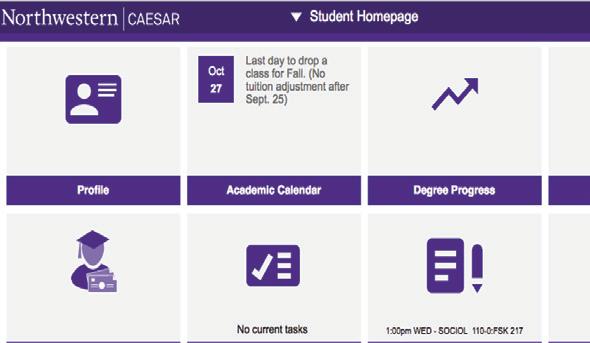
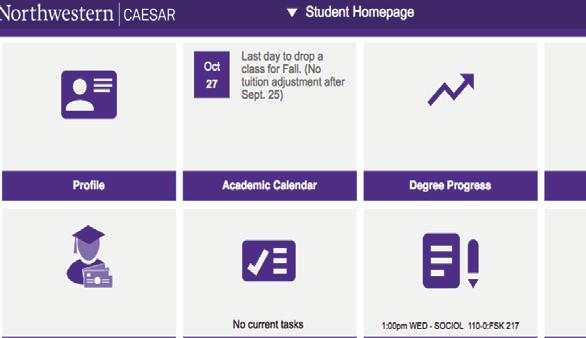










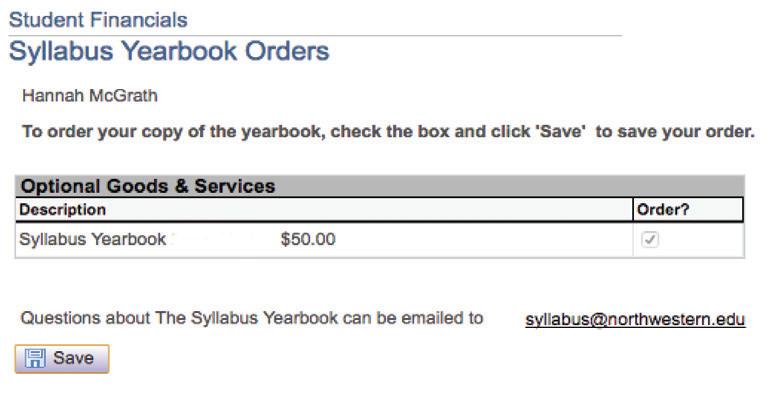





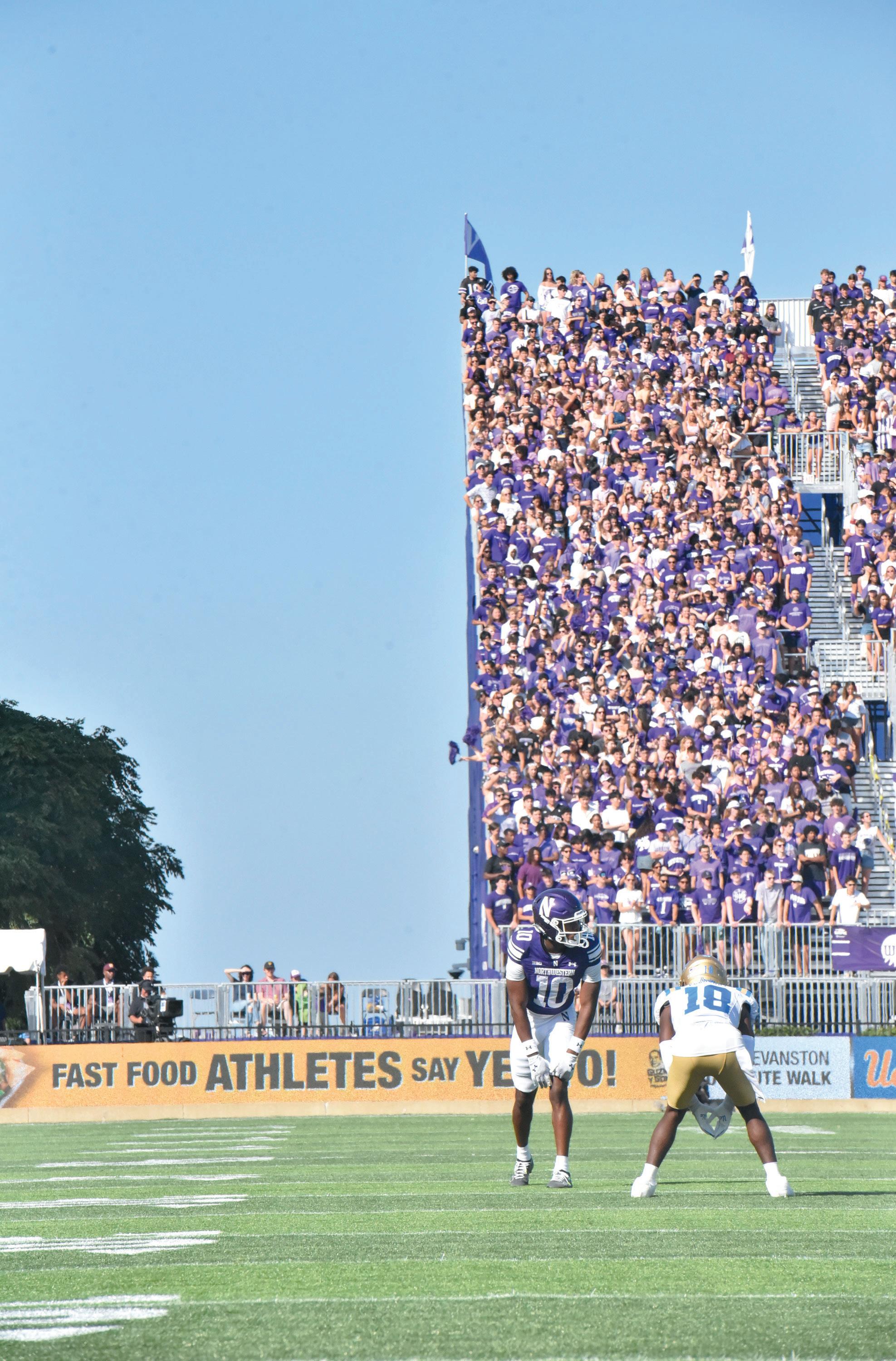

‘my year’
How Robert Fitzgerald is making his 2025
ascension
By ANNA WATSON daily senior staffer
@adub_sports
Redshirt junior safety Robert Fitzgerald made up his mind at the end of last season. With former teammates in the secondary graduating and transferring out, 2025 was bound to be different for Fitzgerald.
“I was like, ‘All right. This is my year,’” Fitzgerald told The Daily on Tuesday. “... It was really my spot to lose, and I made up my mind that I wasn’t going to let that happen.”
The time and effort that followed by improving sleep and nutrition, watching film with staff, training and staying healthy has resulted in a remarkable start to the season. Through four games, Fitzgerald leads the Wildcats (2-2, 1-1 Big Ten) with 36 total tackles and 22 solo tackles, a figure that ranks tied for ninth-best among all FBS players.
“A guy like that, that cares about football that much and loves football like that, he has a chance to be really, really good,” safeties coach Harlon Barnett said.
Fitzgerald’s love for football has existed for a long time. Despite playing “every sport” growing up, football has always had his heart.
Fitzgerald started playing flag football in grade school and switched to tackle football by fourth grade. Motivated by his dream of becoming a Green Bay Packer, he took his talents to Jesuit College Prep in Dallas.
During his freshman year of high school, Fitzgerald wasn’t on the varsity or junior varsity team. Instead, he played quarterback and safety for his school’s freshman team.
He did not have to wait much longer to take his talents to a broader stage.
“We knew he was a really good athlete and had a great knack for the game of football,” Jesuit Dallas coach Brandon Hickman said. “... He was a student of the game. Very mature at a young age.” Fitzgerald began playing varsity football in his sophomore year of high school. During his three years on the team, Hickman said he was a renaissance man, playing safety, running back, wildcat quarterback, punt returner and kick returner.
A year on varsity helped him realize that he wanted to put everything into football and one day play at the next level. College coaches were as eager to make his dream come true. After nabbing a team-high four interceptions his sophomore year, Fitzgerald began garnering interest. Three games into his junior season, he received his first offer from Colorado.
It would be his very last offer, though, that changed everything. Northwestern came knocking in June before his senior season.
Before making his final decision, Fitzgerald had to give his best in his final season at Jesuit College Prep. In 2021, Fitzgerald worked 71 total tackles, three interceptions and six pass breakups. On the offensive side of the ball, he rushed for 877 yards and 19 touchdowns, while catching 20 passes for 184 yards and two touchdowns.
His performances earned him honors such as Dallas Morning News and Dave Campbell’s Texas Football Built Ford Tough Player of the Week and an IHSS Football MVP Bobblehead recipient, which people started calling the “Robblehead.” Fitzgerald, whose nickname is Superman,
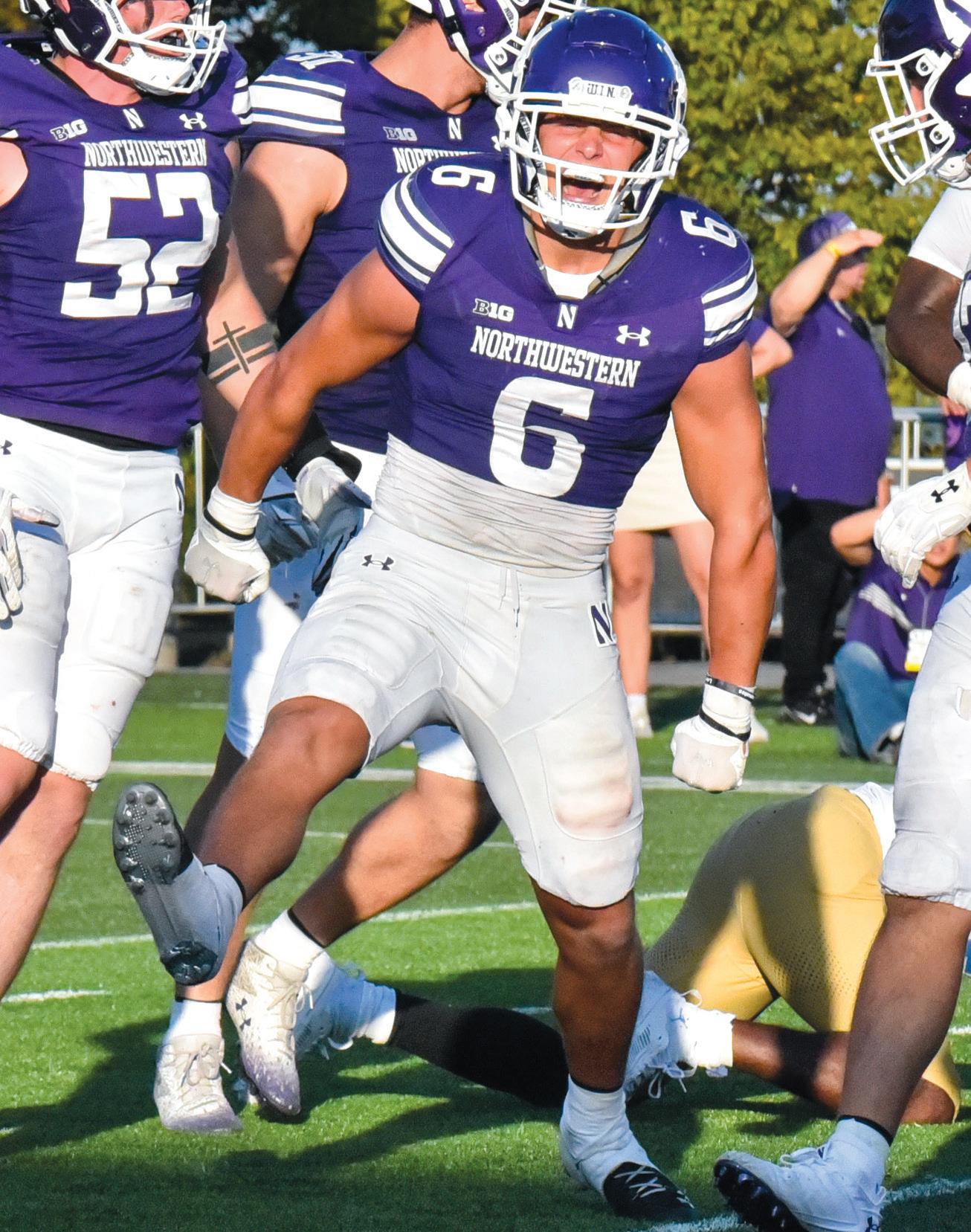
according to Hickman, was a one-of-a-kind player.
“I’ve been here 21 years at Jesuit, and I’ve never coached a player as good as Robert Fitzgerald as a whole,” Hickman said.
After the season, Fitzgerald made the decision about his future, picking Northwestern over Duke and Vanderbilt.
With a father from Chicago, a good community of family and friends and the chance to play Big Ten football with an elite education, the program made it difficult for him to pass up the opportunity.
“The people in this program are very special, from the top down,” Fitzgerald said. “From the coaches, to the players, to the training staff, to the equipment staff. Everyone in this building is really special.”
The now-star NU safety did not hit the ground running the same way he did on Hickman’s squad
when he first arrived in Evanston.
“When I got here as a freshman, my head was just spinning,” Fitzgerald said. “Everything was moving so fast. I didn’t really understand the game of football.”
Through the same hard work and dedication implanted in his game since high school, Fitzgerald got through it.
Even in high school, his work ethic and dedication to being at the top of his game were hard to match. Hickman said Fitzgerald showed up for 6 a.m. practices an hour earlier to prepare.
“He would be foam rolling, he’d be sitting in the hot tub, getting prepared, taping himself, he just prepared his body,” Hickman said. “You don’t see many players like that in high school. A guy that really knows how to prepare for practice.”
The same aspect of Fitzgerald’s game has also impressed his college coaches. At his weekly press conference Monday, coach David Braun pointed out that Fitzgerald is “one of the first people in and one of the last people out.”
Barnett also expressed his admiration for how intentional he is about what he does, what goes into his body and his routine.
Offering similar levels of praise as they offered him, Fitzgerald credited his coaches for helping to develop him on the field and in the weight room. All of the work positioned the Dallas native for success. Last season, he played in all 12 games, earning four starts. Perhaps his most notable moment was a game-sealing, first-career interception against Miami (Ohio).
When reflecting on the 2024 season, Barnett said he thought Fitzgerald’s usage could’ve been higher at the safety position.
“I told him at the end of last year that I felt like I did him a disservice, and I thought he should have played more than what he played for us at safety,” Barnett said. “... I said, ‘You’re a really good football player, and I expect a lot out of you, and I believe that you can do it.”
Through this year’s early contests, the opportunities have come Fitzgerald’s way, and he has made the most of them. The defensive back has started all four games this season and has led NU in tackles in three of them.
Saturday, as UCLA threatened to mount a comeback on its second-to-last drive down three, Fitzgerald came up with a critical tackle for loss that disrupted the whole drive.
Barnett said that the way Fitzgerald has continuously applied things he is learning in practice has made his skills better this season.
“I even said to him yesterday watching game film from Saturday, I said, ‘That’s something that you weren’t doing before I got here, but you’re doing it now,” Barnett said. “He said, ‘Yep,’ because he pays attention to everything that you tell him to do.”
Not only has Fitzgerald developed as a player since his freshman year, but he has also developed as a leader. Braun and Barnett lauded Fitzgerald for his ability to teach and help his teammates. Braun went as far as to liken Fitzgerald to “an extension of the coaching staff.”
While Fitzgerald said he has always led by example, he has worked on becoming more of a vocal leader.
“I’ve struggled with that in the past, so that’s kind of where I took that step this year,” Fitzgerald said. “... Being in their shoes at one point, I knew how much help I could provide to young guys in the room and really teaching them a playbook and teaching them how to watch film and how to take care of their bodies.”
In this way, Barnett said Fitzgerald is a guy he can trust as a coach, as his safety can break down information in their language as opposed to a coach’s language. Barnett said he has seen players like Jon Jon Stevens Jr., Alijah Jones and Sean Martin benefit from Fitzgerald’s help.
All the collaboration seemingly makes for a safety room that makes for a good team that is comfortable with each other. Maybe that is why Barnett feels comfortable joking with his guys and giving out nicknames.
“One of the names I give Rob is I call him the Terminator Two,” Barnett said. “... When the guy runs, that’s why I call him the Terminator Two. You can’t kill Rob. He’s gonna keep coming back.”
annawatson2027@u.northwestern.edu
saka cares about wins, not stats
By A UDREY PACHUTA daily senior staffer @audreypachuta
For redshirt junior defensive end Anto Saka, being an “every down force” isn’t something you can see on a stat sheet.
Prior to Northwestern’s most recent win over UCLA, where he had four tackles, one tackle for loss and combined on two sacks, Saka’s name wouldn’t stand out on any box score this season.
It doesn’t bother him.
“I’m not out here stat-hunting, I’m out here just to help my team in whatever way possible,” he said a er the Wildcats’ (2-2, 1-1 Big Ten) Tuesday practice.
For Saka, anything short of contributing to an NU win doesn’t ma er. Not NFL Dra hype, not cha er on whether he’s meeting expectations and certainly not the fact that he was named among e Athletic reporter Bruce Feldman’s “Freaks List” ahead of the season, which his teammates still joke about to this day.
Against the Bruins on Saturday, the veteran edge rusher bookended the victory, contributing to critical sacks on both the visitors’ rst and last drives.
On a third-and-6 rst-quarter play with UCLA driving just shy of the 50-yard line, graduate student defensive back Garner Wallace clutched onto the scrambling opposing quarterback and Saka erupted for the critical takedown, forcing a punt.
NU’s eld goal on the ensuing possession established an early lead, thanks to its defense’s tonese ing start.
en, at the contest’s opposite end — a er
NU saw what had once been a 17-point advantage shrink to three — Saka helped bring down the Bruins’ passer again when it ma ered most.
“It wasn’t anything really special,” Saka said. “It was just me waiting for the opportunity and then not being scared when the opportunity presented itself.”
For graduate student defensive end Aidan Hubbard, who plays opposite Saka, that play was all about sticking to the basics and seizing opportunities as they arise.
“We’d been doing a lot of stunts earlier in the
game, and then once they let us go straight, we were able to a ect the quarterback,” he said.
While both Saka and Hubbard said that the defensive line still has clear adjustments to make, particularly when it comes to in icting pressure in the pocket, they agreed that the cohesiveness of their group both on and o the eld is something that makes the process more enjoyable.
In the o season, the defensive line frequently gets breakfast together, occasionally completes an escape room — though they skipped it this year — and this summer, a ended a pool party at redshirt freshman defensive lineman Landon Lauter’s nearby home.
“ is is probably the goo est group of guys that I’ve ever been around in my life, and I absolutely love it,” Saka said. “Out on the eld, everything’s supposed to be serious and you’re trying to win a football game, but even within those moments we still put a smile on each others’ face, we upli each other.”
Saka described the bond between members of the defensive line as “strong as a diamond” and said that during the season, weekly position group
dinners help the room to get to know each other as people, not just as players.
Outside of social growth that’s helped him and his teammates collaborate more seamlessly, Saka said, adding 15 pounds to his build in the o season has helped his play style become more nuanced. He repeatedly touted the importance of being “stout,” not just as an individual, but as a defensive line unit. He said the additional weight has improved stability in addition to his already notable speed.
Prior to this season, he hadn’t started a game. Despite seeing fewer snaps, Saka was a key weapon in each of NU’s past two campaigns, tallying 3.5 sacks and ve tackles for loss last season. Tacking on weight has helped him in both pass rushing and achieving run stops compared to last year, he said. Regardless of personal growth and accolades, though, Saka consistently puts his role as a teammate at the forefront of his priorities.
“When we’re winning, when we’re balling, that’s the thing that’s most important to me,” he said. audreypachuta2027@u.northwestern.edu
By ALEX BOYKO daily senior staffer @aboyko_nu
Northwestern’s 17-14 win over UCLA on Saturday came with a couple of rsts. Redshirt sophomore running back Caleb Komolafe notched his rst 100-yard game, junior wide receiver Gri n Wilde hauled in his rst touchdown with the program and the team earned its rst conference and FBS win of the season.
On the heels of the con dence-boosting win, the Wildcats (2-2, 1-1 Big Ten) will tackle another rst this week as the team prepares to face Louisiana-Monroe (3-1, 1-0 Sun Belt) for the rst time in program history.
NU looks to nish non-conference play on a high note, and a win would go a long way for a team with a tall task ahead. e ’Cats face the 20th most di cult schedule to close the season, according to ESPN, largely due to a remaining Big Ten slate of teams that have combined for 22 wins so far this season.
On the other hand, the Warhawks travel to Evanston amid an up-and-down season of their own. Louisiana-Monroe is riding high a er snapping a 16-year losing streak against the Arkansas State Red Wolves with a 28-16 win last week, but also lost 73-0 to their only Power Four opponent, thenNo. 21 Alabama.
With that in mind, here are four things to know heading into NU’s nal non-conference game of 2025:
1. Stars in the secondary e ’Cats and the Warhawks are in two very different situations with their respective pass defenses this season. Louisiana-Monroe has allowed the 10th most passing yards per game in the country, with nearly 280, while NU is 20th lowest at just under 160 per game. But they both have a star playmaker on their side.
Redshirt junior defensive back Robert Fitzgerald has found a new gear in 2025, building o an already strong performance last season. He leads all Power Four defensive backs with 36 tackles so far and is already 10 shy of his total last season.
Coach David Braun and his sta have unleashed Fitzgerald’s skillset in their defense, and he’s been everywhere on the eld for the ’Cats. While he primarily plays deep safety for NU, Braun has set up Fitzgerald as a blitz threat in key situations multiple times this season.
around the rushing a ack. NU has played just one game with more passing a empts than rushes, while their opponent has yet to tally one this season.
Keeping the ball on the ground has been a nearnecessity for both teams to succeed, with the two combining for a single win with fewer than 40 rushing a empts — Louisiana Monroe’s aforementioned win over Arkansas State.
e Warhawks in particular lean heavily on the ground game, even more so than the ’Cats, handing the ball o at the ninth-highest rate in the FBS at just under 69% of their snaps. Even when trailing, that number only dips to 64%.
With both sides having a strong run game and a clear game script to keep the ball on the ground with the game on the line, no ma er how the game unfolds, it will likely involve its fair share of hando s.
3. ’Cats performance on the defensive line e Louisiana-Monroe ground game has been instrumental for the team, but it doesn’t come without its weaknesses.















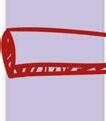







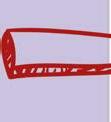




Fitzgerald screamed through the o ensive line a few times on UCLA’s nal possessions, picking up a tackle for loss with UCLA pinned back in their own territory and forcing quarterback Nico Iamaleava to step up into a sack on the second-tolast play of the game.
For the Warhawks, newcomer defensive back D’Arco Perkins-McCallister has made a name for himself in a similar way.
e transfer from Cha anooga was named Sun Belt Defensive Player of the Week in his rst game with the program a er tallying the rst two sacks of his career. Perkins-McCallister tacked on another in the win over Arkansas State, and he leads the FBS in sacks by a member of the secondary.
Both he and Fitzgerald are dynamic playmakers on the backend and should be able to contribute heavily on Saturday with their ability to make an impact in the back eld.
2. Ground and pound
Both the ’Cats and Warhawks revolve their o ense





















e Warhawk o ensive line has allowed just two sacks, partly because of the theatrics of quarterback Aidan Armenta, but the team still ranks fourthworst in the FBS with 7.5 tackles per loss allowed per game and goes backwards on 12.7% of their runs this season.
Allowing 12 tackles for loss to the Crimson Tide skews this slightly, but Louisiana-Monroe has still struggled against weaker opposition, with Saint Francis (PA) notching eight against them as well.
NU’s defensive line has been disruptive as of late despite a slow statistical start to the season and should have an opportunity to tee o against the Warhawks’ line on Saturday. If the ’Cats can nd a way to take advantage of this and consistently put the Warhawks behind the sticks, it skews the advantage in their favor.
alexboyko2026@u.northwestern.edu
pachuta: nu’s offense should roll the dice
By AUDREY PACHUTA daily senior staffer @audreypachuta
When your anemic offense is rolling, you gotta let it roll.
Hosting a struggling UCLA squad in its lakeside abode Saturday, Northwestern entered halftime with its largest mid-game lead over a Big Ten opponent in offensive coordinator Zach Lujan’s 16-game tenure.
By the time 30 minutes had elapsed on the game clock, NU’s second-year play caller had seen the fruits of his labor. In stark contrast to his quarterback’s interception-riddled debut three games back, graduate student passer Preston Stone had already completed nine of his 11 attempts and thrown for more than 100 yards. On the ground, NU’s running backs matched Stone’s output, averaging 6.8 yards per carry.
Perhaps best of all for Lujan’s own report card, junior wide receiver Griffin Wilde — who followed him from South Dakota State ahead of the season — had racked up 83 receiving yards and scored the Wildcats’ second touchdown to go up 17-0.
The stats alone weren’t much to write home about, but the way Stone and company controlled both possession and pace surely was.
Well on its way to an emphatic, statement victory, NU’s offense seemed to flick on cruise control and take one hand off the wheel. From that point on, Lujan’s group played it safe as conservative play calling defined the game’s latter half, allowing an onslaught of stuffed run plays to trickle time off the clock.
An NU offense in rhythm returned from intermission with choppy, repetitive drives, all of which ended in questionable field goal attempts and decisions to punt.
On a day when a commanding defeat was well within grasp, the ’Cats stopped playing like a team looking to avenge its low-scoring losses of days past and settled for simply scraping by.
The shift in tempo nearly failed them.
With NU’s foot off the gas, the Bruins began to creep back in, tacking on a third-quarter field goal and a fourth-quarter touchdown to cut the hosts’ advantage to just three points.
Forced to relinquish possession with three minutes left to play, a perfect punt by graduate student punter Luke Akers, followed by sturdy NU defense, prevented the visitors from scoring on their final drive with three minutes to go.
Still, thanks to the offensive slowdown, this was hardly the tone-setting win it should’ve been.
Stone went on to throw for just 11 yards after halftime, completing three passes on only seven attempts. Of course, a team with a lead will traditionally lean on the run game and focus on protecting the ball. But for a group that could surely use a Big Ten confidence boost after just two conference wins under Lujan, repeatedly handing off to redshirt sophomore running back Caleb Komolafe for small gains nearly caused more harm than it did good.
Whether or not the ’Cats should have kicked the blocked fourth-quarter field goal up 17-6 is an
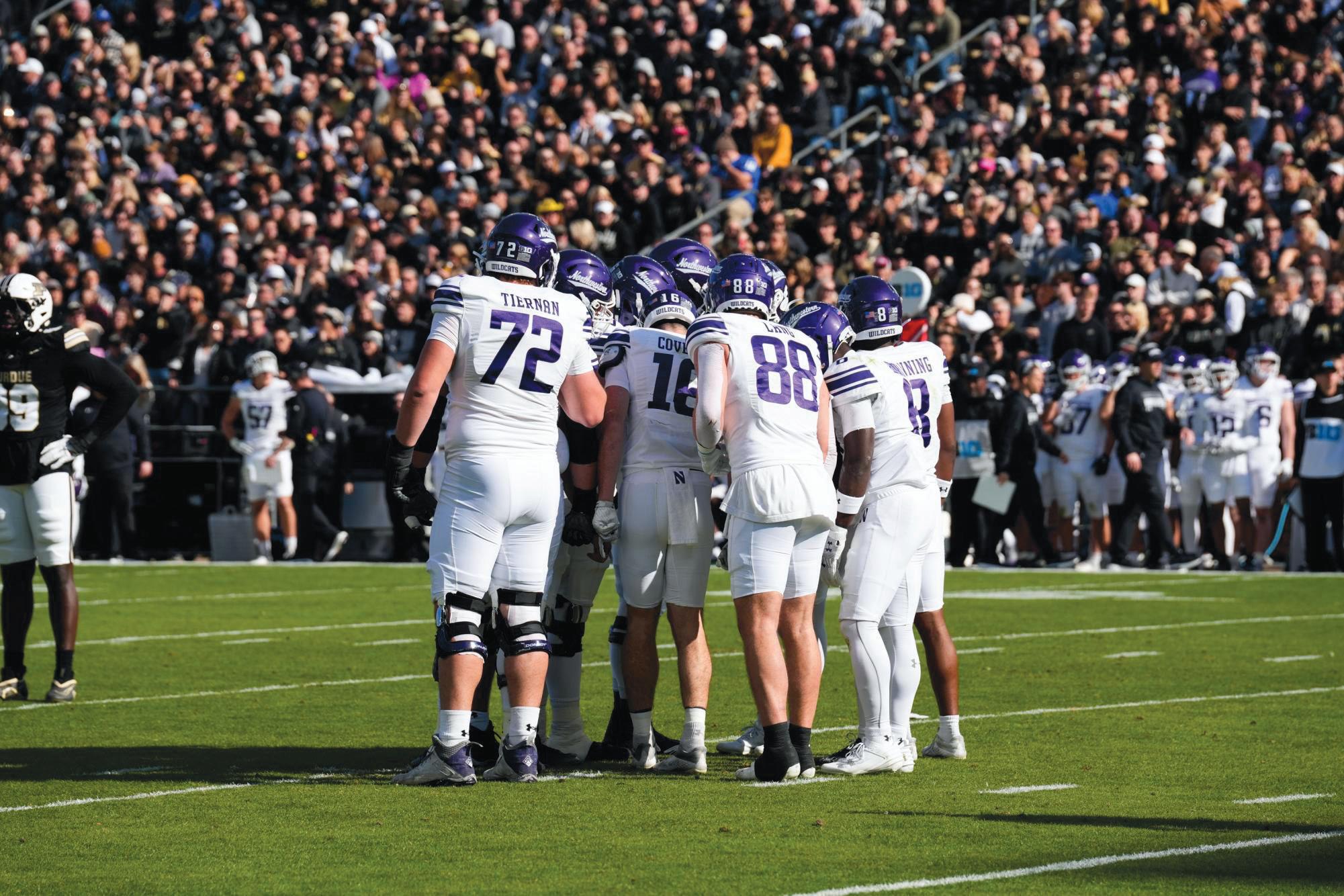
easier conversation in retrospect, but had they taken a chance, making it a three possession game would’ve likely have closed the door on the Bruins.
NU defense’s clutch play on UCLA’s final drive confirmed the winning result, but just because the secondyear coordinator’s group was bailed out, it doesn’t mean there aren’t offensive questions worth asking.
After calling an electric opening half Saturday, Lujan clung to the same sheltered play call that ensured the ’Cats were the worst in Big Ten yards per game last season. Prior to NU’s first win of 2025 over Western Illinois, it had scored either one or zero offensive touchdowns in seven of 13 total games with Lujan on staff.
In each of the last three games, the ’Cats have surpassed the one-touchdown output, but throughout Lujan’s tenure, they’ve struggled to find the offensive cohesion necessary to convincingly fend off its more daunting foes.
Last season, NU’s offense recorded just 12 touchdowns against Big Ten challengers, a far cry from the conference’s top drawer, where teams like Indiana and Oregon recorded 40 or more.
Against UCLA, the ’Cats showed glimpses of greatness in the first half, but the final score didn’t show it. For a Wildcat squad looking to establish itself as a competitor as it stares down the bulk of its conference slate, a blowout win would’ve raised their stock before they turn to tougher competition following a sandwich game against Louisiana-Monroe.
Pouncing on their opponents’ miscues as they travelled to Evanston with a new interim coach, the ’Cats came away with the necessary outcome. It could have been so much more.
Granted, a Bruins team that would be among the worst in the Mountain West after season-opening losses to New Mexico and UNLV is hardly the tallest task on NU’s grueling schedule. But a two-touchdown lead over a conference challenger is no meager feat — especially for Lujan, who has been the subject of sharp criticism throughout his tenure.
Lujan’s come a long way from his original sin more than a year ago, when, in double overtime against Duke, he opted for a pass play on 3rd-and-1, rather than handing off to a veteran running back who already scored two touchdowns.
In his second year in the role, the former Jackrabbits’ coordinator has made clear improvements from his earliest games at NU, but still has a lot to learn when it comes to keeping pace with other Big Ten offenses. It didn’t take long for him to earn the respect of his promising (albeit, somewhat erratic) transfer quarterback.
“Coach Lujan is maybe the smartest coach I’ve ever been around,” Stone said at Big Ten Media Days ahead of the season. “From a scheme standpoint, from a terminology standpoint, everything we do is a master’s-level offense. At the same time, he communicates it to you in a way that’s very understandable and digestible.”
Establishing trust is an obvious starting point for a team looking to forge a new identity with fresh talent, but if NU hopes to avoid being relegated to the Big Ten basement — alongside UCLA, of course — it’s gonna need its play caller to show some guts. Otherwise, far less attractive fates against its upcoming conference adversaries wait just around the bend.
audreypachuta2027@u.northwestern.edu
wilde emerges as stone’s go-to target
By ANDREW LITTLE daily senior staffer @little_andrew_3
Whenever Northwestern dialed up a big passing play Saturday against UCLA, there was a simple formula: find No. 17.
Since joining the Wildcats (2-2, 1-1 Big Ten) this offseason upon transferring from South Dakota State, junior wide receiver Griffin Wilde has made the FCS to FBS transition look seamless. He caught his first touchdown with NU Saturday in the 17-14 win over the Bruins. In that game, he had four receptions of 15-plus yards and finished the day with a team-high seven catches and 98 yards. Through four weeks, Wilde is tied for seventh in the Big Ten with 22 receptions and solo-10th with 311 receiving yards. He is the only player with double-digit receptions or 100-plus receiving yards for the ’Cats and has quickly emerged as the team’s top receiving option.
“(Griffin is) very internally competitive and confident in his ability,” coach David Braun said during his weekly press conference Monday. “The level of trust that he’s built up with his entire offense, all his teammates and specifically Preston Stone is something that stands out.” Wilde has led the NU in receptions and receiving yards in each of the first four games, becoming the first NU wide receiver to do so since former All-American Austin Carr in 2016. He and graduate student quarterback Preston Stone have developed a quick rapport, and their connection has been the engine of the ’Cats’ passing game through four games.
“(I’m) just trying to build (Stone’s) confidence in whatever way I can,” Wilde told The Daily on Tuesday. “Either catching the easy balls always and
making the hard catches for him. If he wants something after practice, we’re staying after throwing extra balls or watching film. (We’re finding) little things to be together more often.”
NU lost five of its six leading pass catchers from 2024 in the offseason, including graduating multi-year starting wide receivers AJ Henning and Bryce Kirtz. Tasked with replacing over 75% of the team’s receiving production from last year, the ’Cats have leaned on a young and largely unproven wide receiver corps.
Wide receivers Drew Wagner, Ricky Ahumaraeze, Frank Covey IV and Hayden Eligon II, have also rotated as starters. Of the young group, Wilde has been Stone’s go-to target with 22 of the team’s 63 catches.
Wilde said being in NU’s wide receiver room has been exciting, as the group is hungry to take advantage of opportunities to improve.
Both Stone and Wilde made their way to Evanston this offseason via the transfer portal. At SMU, Stone played in a high-volume passing offense that included several current NFL wide receivers. Stone had high praise for Wilde — the former FCS star — after defeating UCLA Saturday, already lauding him as one of the best receivers he has played with.
“Griffin’s the man. He’s a special dude,” Stone told reporters postgame Saturday. “I’ve been blessed to play with some really good receivers since I’ve been in college, like Rashee Rice and Danny Gray, and Griffin’s right up there. He’s one of the best receivers I’ve ever thrown to.”
Wilde had a dominant 2024 season with South Dakota State, with 71 receptions, 1,147 yards and 12 touchdowns. That earned him FCS Football Central All-American Second Team and All-Missouri Valley Football Conference Second Team honors. Since making the jump to the Big Ten,
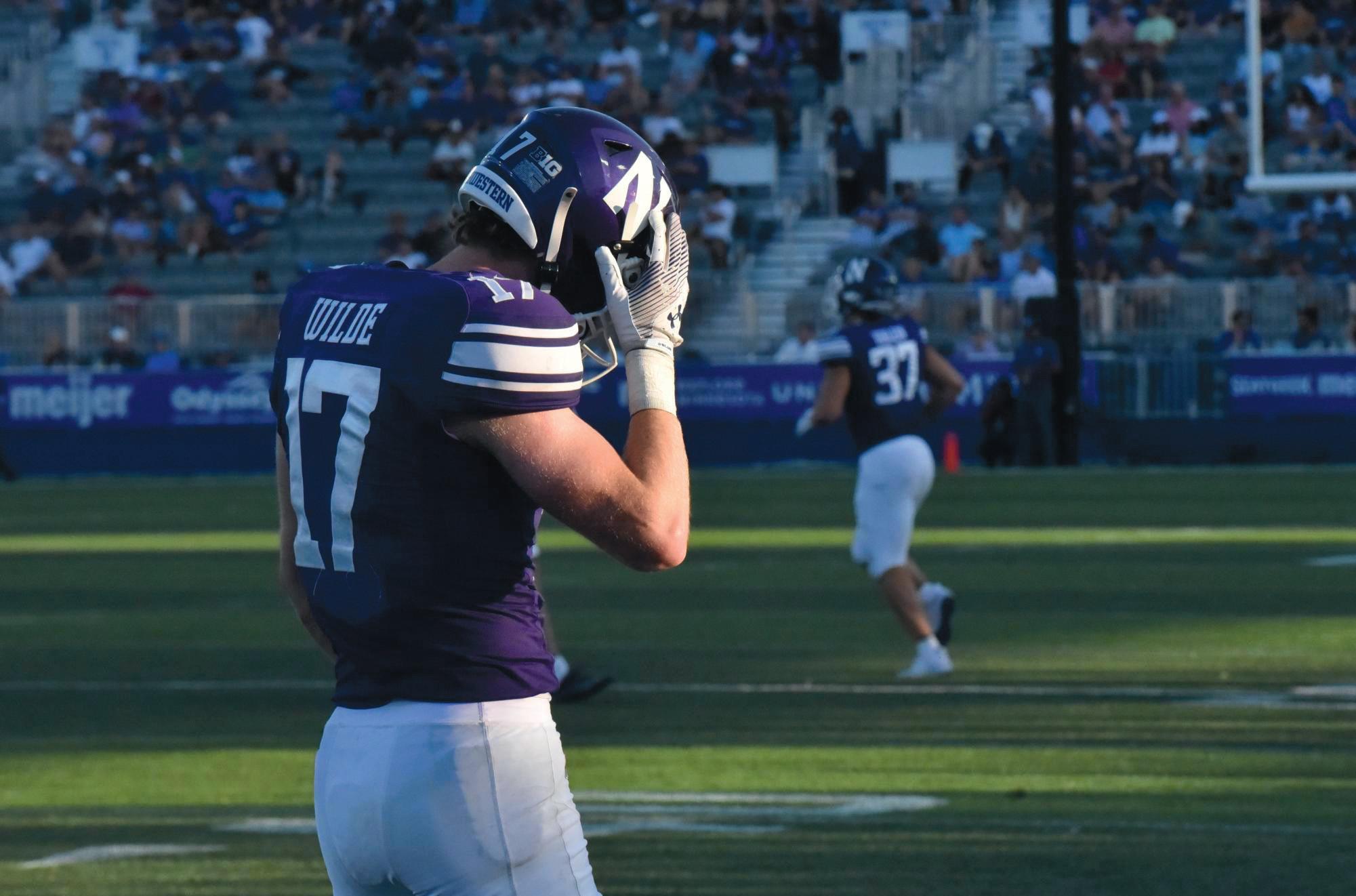
Wilde has adjusted his game to find immediate success with 153 receiving yards in two conference games.
“As advertised, everyone is bigger, stronger, faster and a little more assignment sound (in the Big Ten),” Wilde said. “Getting open half a second earlier, seeing the coverage a little bit earlier is stuff that I continue to grow at.”
Following the trail of offensive coordinator Zach Lujan, who spent seven years at SDSU before joining the ’Cats in 2024, Wilde and graduate student offensive lineman Evan Beerntsen transferred from
and
the Jackrabbits this offseason. Lujan coached both players during SDSU’s FCS national championship run in 2023. Wilde said his familiarity with Lujan and his scheme has allowed him to adjust quickly to NU and Big Ten football.
“It definitely made the transition really easy,” Wilde said. “It’s part of the reason I’ve been able to come in and help the team as early as I have. Knowing Lujan, it’s a comfort level to know the OC and what he’s about.”
andrewlittle2028@u.northwestern.edu
leaders have said the autonomy could give them more control over facilities and finances.
“It’s not just a place of books,” EPL Board of Trustees President Tracy Fulce said. “The modern age requires much more of us than we previously needed.”
In 2024, EPL logged more than 440,000 visits and hosted programs for all ages with over 20,000 attendees ranging from puzzle swaps to language classes, drawing everyone from children to seniors. The library has also served as a heating and cooling center and provided access to services such as vaccinations, Fulce said.
But the potential split has also sparked concerns about costs, labor protections and new risks for taxpayers.
A split on the table
A roof replacement looms with a $1.9 million price tag, alongside an estimated $19 million in extensive renovations to the library’s main building.
The city currently owns the main building, meaning EPL is unable to borrow against the property.
“We have not yet gotten to the place where we fully have landed on an intergovernmental agreement with the city and a lease arrangement,” Fulce said.
There is also debate about whether EPL is obligated to pay for the building’s maintenance and repairs in its entirety. Based on a 2014 Memorandum of Understanding, the city and library have a “shared responsibility” for the costs of maintaining library facilities.
The board has pushed for an agreement clarifying who is responsible for maintaining the main branch, but so far, no new Memorandum of Understanding with the city has been reached. If a split from Evanston were to happen, the library would need to secure enough funding to buy the building, Fulce said.
According to Fulce, one official position that the board has discussed — but has not committed to — is the city transferring the building to EPL.
“If they transfer that asset, then we could perhaps take on debt against the asset and not have to separate,” Fulce said.
In a joint written statement from September, the library and city said they are “in active discussions and working collaboratively toward a resolution.”
The two entities are hoping for an agreement “that continues to serve the best interests of the Evanston community,” the statement read.
Taxes and funding
EPL is primarily funded through a property tax levy. Evanston property owners currently pay about 0.22 percent of their property’s equalized assessed value to support the library.
As long as the library remains under city oversight, the board can recommend increases to the levy, which City Council would then have to approve. If EPL became an independent library district, however, state law would place a cap on how much the levy could grow each year.
At its Sept. 17 meeting, the library board passed a levy recommendation to raise the rate by 10%.
Fulce said that this increase just barely makes the budget even, given the cost of the AFSCME contract and the necessary building repairs.
“We’ve been so conservative that we’re actually perhaps causing ourselves harm,” she said.
In 2024, EPL budgeted almost $9.2 million in spending, the vast majority from the city tax levy at $8.2 million. Gifts and endowments made up just 7% of the budget, while grants and intergovernmental funds provided under 3%.
More than three-quarters of the budget — $7.3 million — went to salaries and benefits, with about $900,000 for its media collections.
Fulce says when the library’s North Branch closed in 2020 and the city sold the building, the library did not receive proceeds from the sale, despite having paid for its regular maintenance over the years.
More recently, a sewage rupture at Main Library forced the library to spend $685,000 on repairs — nearly 8 percent of its $9 million budget.
“If you ask any citizen, ‘What should the library be spending their money on?’… they’d be like, ‘(Media) collections,’” Fulce said.
Because the library cannot issue debt on its own, major repairs must be paid in cash from its fund balance. Fulce warned that with the projected future renovations, this model is “untenable.”
And, the longer it takes for the library to begin repairs, the worse the problem gets, she said.
“Immediately for the taxpayers, it’s more expensive. It probably would level out eventually, but it’s like, what is the best option?” Fulce said. “I think for both the city and the library, we think the best option is really not splitting. But how do we solve the problem of the day?”
The governance question
In 1870, the Evanston Library Association was founded when a group of local residents first opened a public reading room downtown. By the early 20th century, demand for a permanent facility grew. In 1903, the library moved to 1703 Orrington Ave., its current location.
EPL also operates a bookmobile and a smaller branch inside the Robert Crown Community Center. The library has 58 full-time and 41 parttime employees. Its operating budget is over $10 million dollars.
The library is “financially stable” but reliant on the city, according to an August presentation from Meristem Advisors, a consulting firm the EPL board hired to advise it on what a potential split might look like.
Meristem also advised the Aurora Public Library on their split from the city of Aurora in 2020 — a decision that was initially spurred by a desire to elect their own library board.
Independent library districts elect their own board, which confirms the budget, as opposed to city council doing so for city libraries.
Michaela Haberkern, the executive director of the Aurora Public Library District, said that Aurora’s library leadership made the case to staff that becoming a library district would allow them more local control.
“The board who works with you on a daily, or at least monthly, basis on library governance, and who have an intimate understanding of what the library’s needs are are the ones that are making decisions for you,” Haberkern said.
According to Illinois law, a library’s split from the city to become an independent district requires a referendum or the consent of both the city council and the library’s board of trustees.
The latter was the case in Aurora, Haberkern said. However, a critical difference between Aurora and Evanston, Haberkern said, is that the Aurora Public Library owned its facilities before making the transition.
Community and labor impacts
With salaries and benefits making up 75% of expenses, staff argue that any uncertainty around these issues is especially concerning.
According to AFSCME Local 1891 president Eileen O’Neil, approximately 75 library employees are part of the union. The number represents the majority of the library’s employees except for management, she said.
Currently, library staff are part of the city’s Illinois Municipal Retirement Fund pension system, a health insurance pool covering nearly 1,000 employees across the city. In the event of a split, EPL has “glossed” over what would cover employees’ pension and health care, O’Neil said.
“These are large, large topics to not have answers to be talking so seriously about separation,” she said.
Lorena Neal, a librarian and union steward with AFSCME Local 1891, pointed to recent tensions over “shift differential” pay — the small bump employees are contractually owed for working outside their scheduled hours.
According to Neal, management restricted staff from running evening and weekend programs rather than pay the difference.
She also questioned the financial case for independence, noting that the library would have to assume costs currently covered by the city, ranging from legal services to facilities maintenance.
“The library hasn’t shown any realistic cost savings,” Neal said. “In fact, operating independently could be more expensive.”
Neal added that past renovations and building repairs were always handled in partnership with the city, and there was no reason that relationship couldn’t continue.
Beyond labor relations, O’Neil warned that independence could burden taxpayers by duplicating city services the library currently relies on, from technology and human resources support to fleet operations.
While not connected to the city split proposal, O’Neil pointed to the library’s decision earlier this year to leave the Digital Library of Illinois as an example of a “dramatic change” the library has experienced this year. According to her, this led to fewer offerings for readers on the Libby ebook platform.
O’Neil said that it was “just one example on a very small scale of the library trying to provide a service on its own without being part of a larger consortium.”
This change did not go unnoticed.
Evanston resident Catherine Westbrook said she most often utilizes the ebooks that EPL offers and was disappointed by the smaller catalog and longer wait times.
However, she said regardless of the change, she will continue utilizing the library’s resources because of her own limited collection.
“I’m a big library user, always have been,” Westbrook said. “And if it is beneficial to the library to make that split, then I’m in favor of it.”
y.huang@dailynorthwestern.com
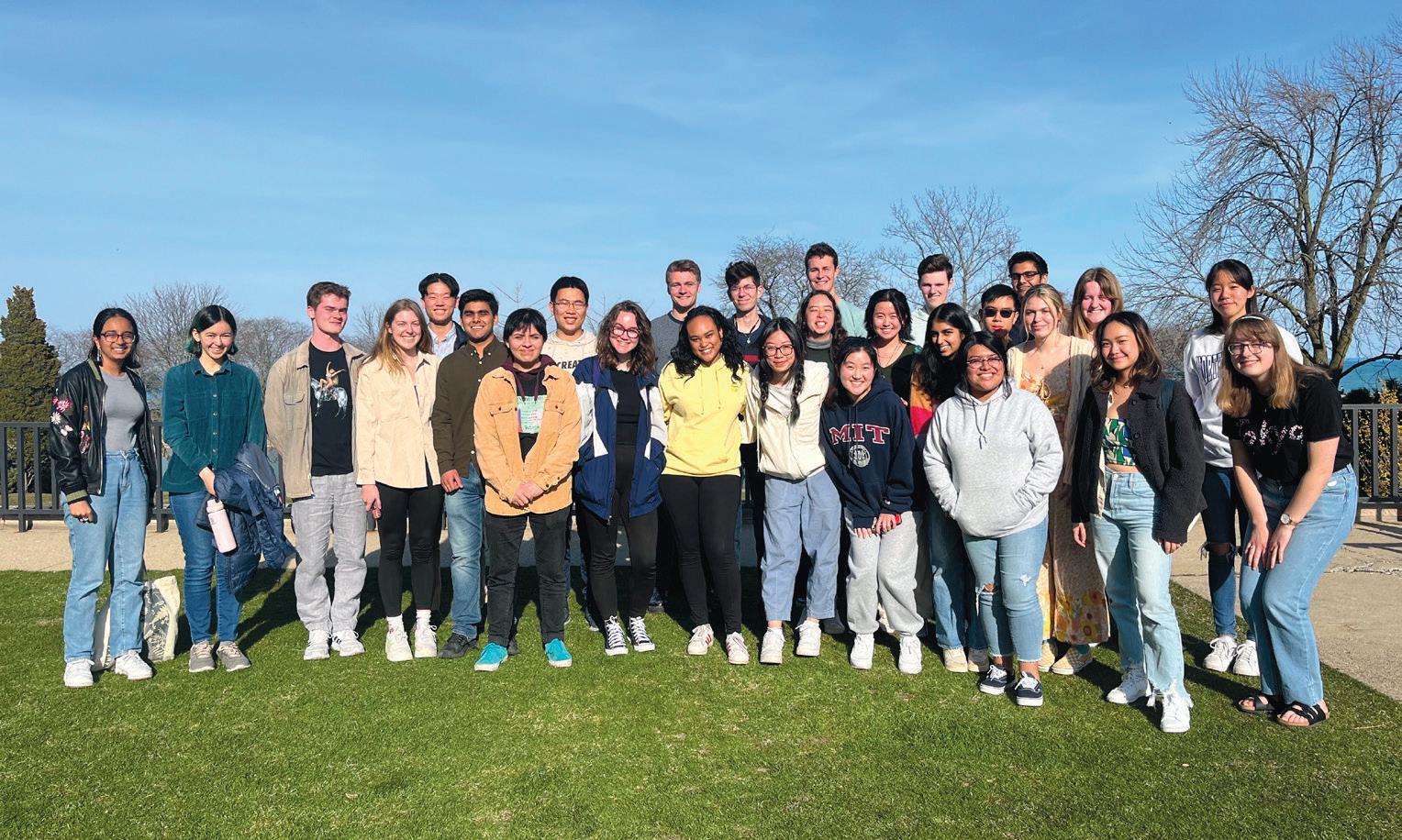






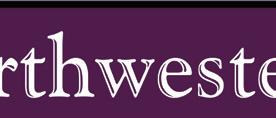
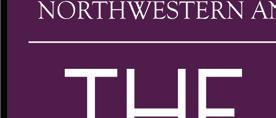






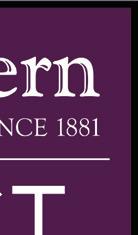
















Introducing our Fall 2025 Opinion Columnists!
By AIDAN KLINEMAN opinion editor
The Daily Northwestern Opinion Desk is proud to name nine columnists for the Fall 2025 Quarter, in accordance with its commitment to providing a platform for the diverse perspectives of the Northwestern and Evanston communities.
On campus and around the world, our student columnists will use their backgrounds and experiences as foundations to produce regularly-occurring pieces on a wide range of topics — from news and politics to advice,
My column will give a glimpse of what it’s like to study at Northwestern University in Qatar, while also branching into re ections on lms, books, art, music and the cultural currents that shape how we live. I want to explore ideas that feel both personal and universal, with a sprinkle of existential re ection woven throughout. At its heart, “Yes-sentials” is about uncovering meaning in the ordinary and questioning the systems we o en take for granted. Fun fact about Aizere: I’ve probably rewatched “How I Met Your Mother” over 10 times.

GABRIELA HAMBURGER MEDAILLEU OFF THE RECORD
“O the Record” is about the conversations we have when no one else is listening. Late-night dorm talks, taxi rides abroad, messy debates about money, politics, God, love — all of it. I want to capture the curiosity, humor and chaos of thinking out loud and show how we gure out life (or at least try to) together. Inspired by “Nerdwestern” culture, “O the Record” is about asking bold questions, sharing stories and nding meaning in the small, intimate moments that o en go unheard — the ones that typically live o the record. Fun fact about Gabriela: I’m currently in Amman, Jordan studying Arabic!
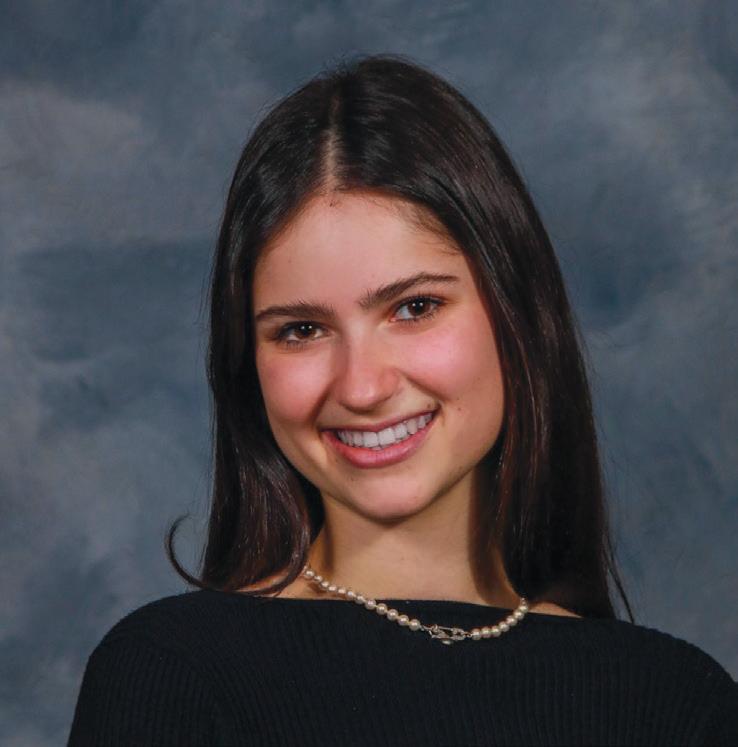
humor and local music.
It has never been more important to use platforms like The Daily to share your voice. We look forward to continuing the work of inspiring civil discourse in the NU community, and we hope you will join us by contributing to The Daily Northwestern Opinion section. As always, submissions should be forwarded to opinion@dailynorthwestern.com.
a.klineman@dailynorthwestern.com
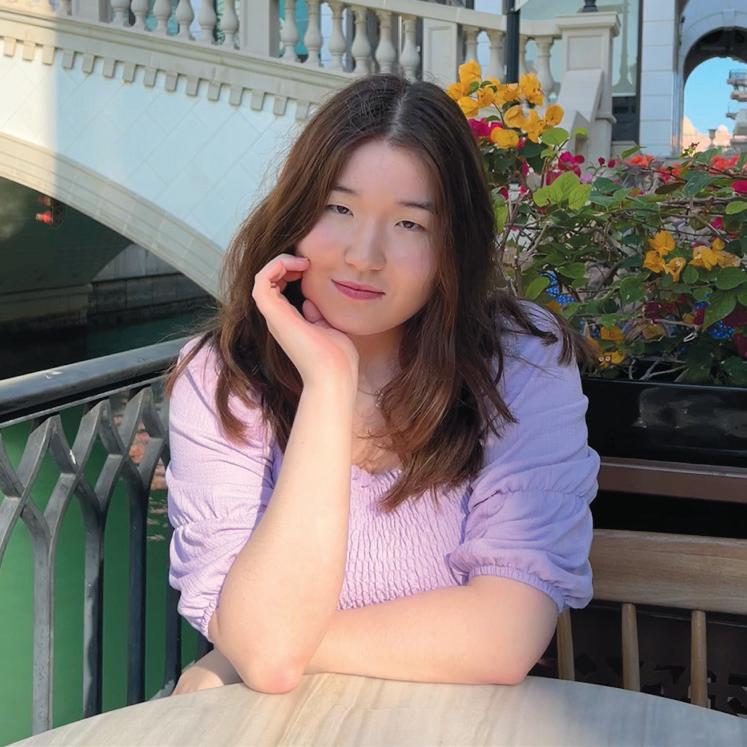
ARLETTE CORREA RENT FREE
“Rent Free” will be about everything but necessary knowledge. As a 19-year-old girl, I am prone to obsessing over the most frivolous things, sometimes for days on end. I may be too online sometimes, but I enjoy the small things in life. I hope to bring joy to the middle of your week with a random insight into what’s been living in my brain for the last week, whether it be a movie obsession or a rant about my latest worry.
Fun fact about Arle e: I went to boarding school in the middle of Ohio!
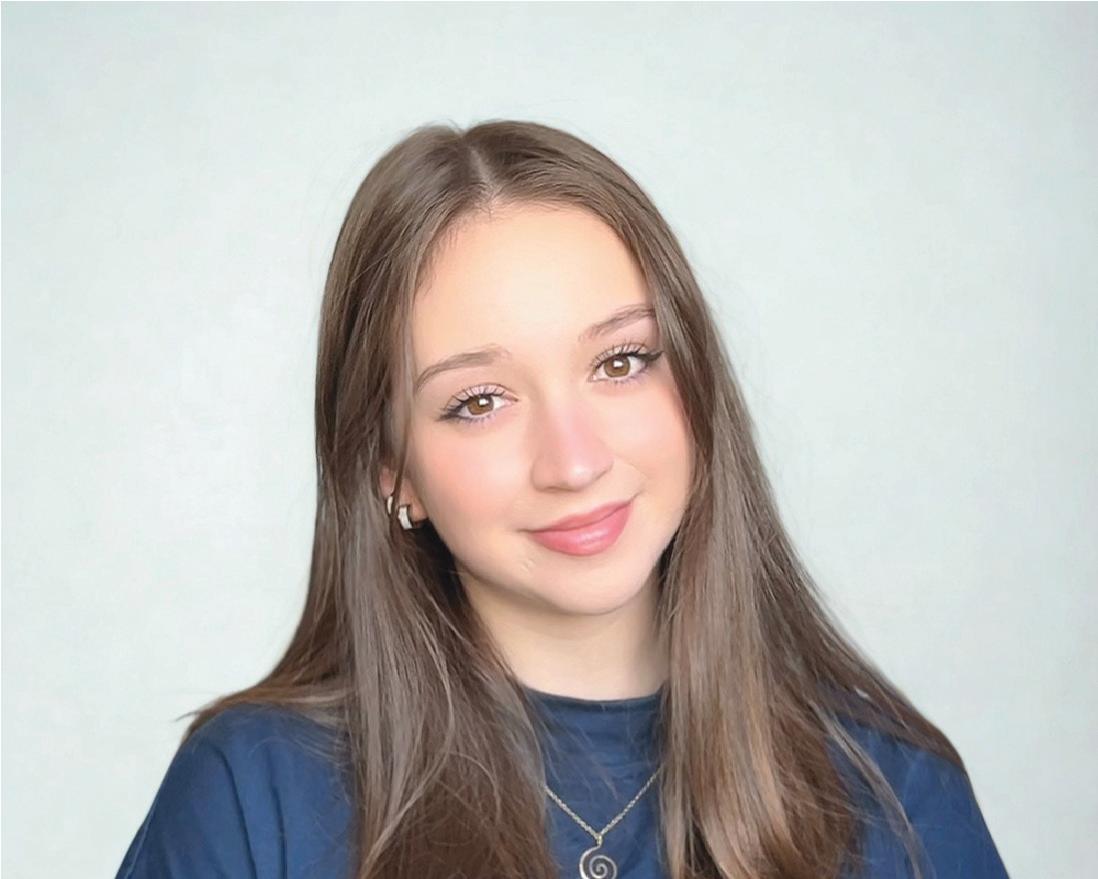

SYLVIE SLOTKIN COMMUNAL SHOWER THOUGHTS
“Communal Shower oughts” focuses on whatever I’ve been thinking about in the shower that week — usually nothing too deep. As a not-so-undercover lover of gossip, I’m pleased to share that people text each other my column — I’ve seen it happen in class. It’s pre y hard to miss “Shower oughts” Girl, she’s unapologetically in your face and unafraid to instigate.
Fun fact about Sylvie: Tomatoes.
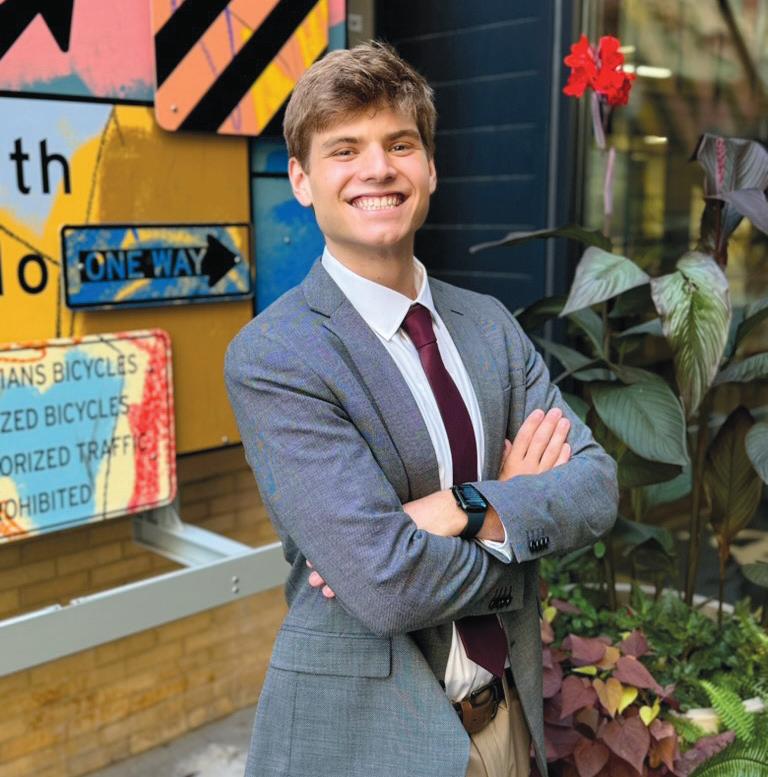
AIDAN KLINEMAN
OFF-CAMPUS: WHITE HOUSE
“Off Campus: White House” is the successor to a column I authored last year, called “Fourth Wall.” With a renewed focus on national politics and how they affect us, I hope to bring readers an authentic and informative assessment of the most critical issues facing our nation and, by extension, our university. I seek to understand why we face them and what on Earth we can do about it. Fun fact about Aidan: I can wiggle my ears pre y well.
“Margin Notes” is where I unroll the ball of yarn that is my thoughts about the world — un ltered opinions, hot takes and inconvenient truths about day-to-day life as a college student. From the campus world and beyond, this column is about noticing and admi ing the things a lot of us think but are too afraid to say. Messy, funny and a li le too honest — the notes we make in the margin, out loud.
Fun fact about Alexia: I had a pet chicken. His name was Mr. Chicken.
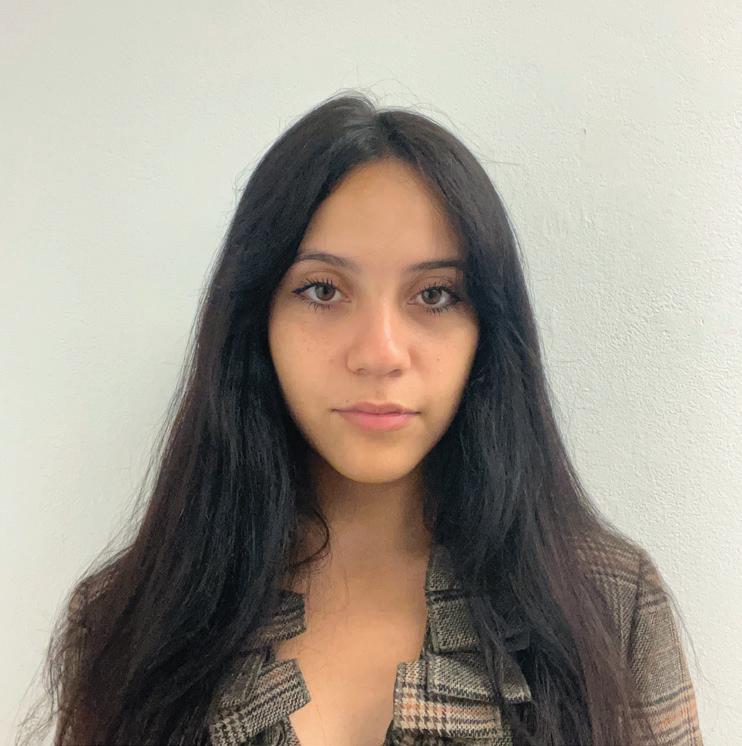
RAWYA HAZIN DEAR READER, LOVE WYA
Dear Reader, If I experience something I love, I’ll cherish it, romanticize it, gi -wrap it — and then I’ll share it all with you. is column is a space for all things tender, confusing, ordinary and extraordinary about being human. I’ve always had a so spot for the slow detours we take to happily pi er-pa er through this life — enjoying the experience without rushing to arrive. Feel free to reach me anytime and always. Love, Rawya.
Fun fact about Rawya: ‘Rawya’ means storyteller in Arabic — I might just have the rst parents in history who’d be disappointed if I didn’t become a writer.



CORDELIA AGUILAR
EARWORM
“Earworm” will center on the local music scene, giving thoughtful coverage to the bands, student artists and projects that o en go unnoticed. Inspired by the DIY ethos of zine culture, I hope to spotlight the music being made right around us — from basement shows to late-night radio picks. ese won’t be traditional reviews, but re ections that are anecdotal, sometimes a li le messy, but always full of heart. I want “Earworm” to feel like a living, breathing part of our local soundscape.
Fun fact about Cordelia: I love tactile and handmade storytelling!


TALIA WINIARSKY
TALIA’S TAKE
I will write about whatever I’ve been thinking about for the week, with topics ranging from national to school politics and culture. I love to read, and my pieces are typically inspired by things I’ve read throughout the week. I hope that my column sparks discussion on campus — I am always happy to talk about my columns and ideas further. Please reach out if you’d like to chat!
Fun fact about Talia: I’ve interned on Capitol Hill!
Ducks Dan and Dave: Raucous Language
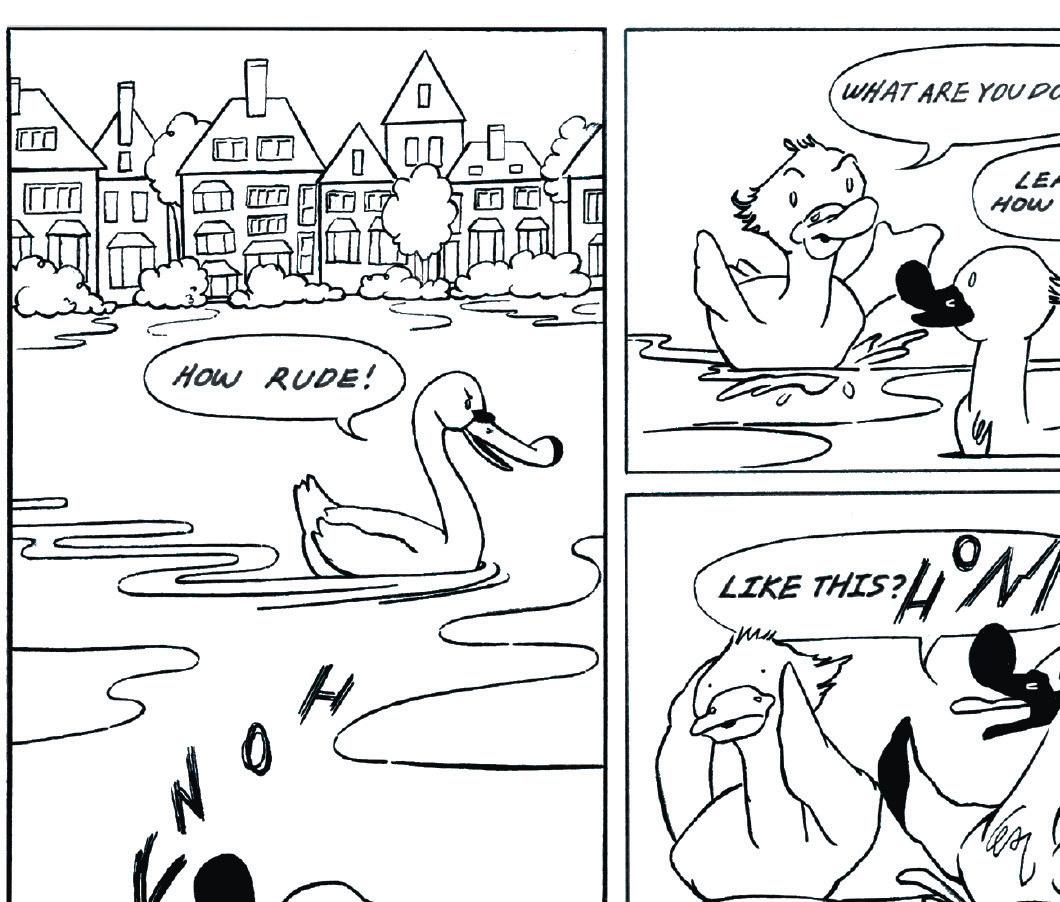
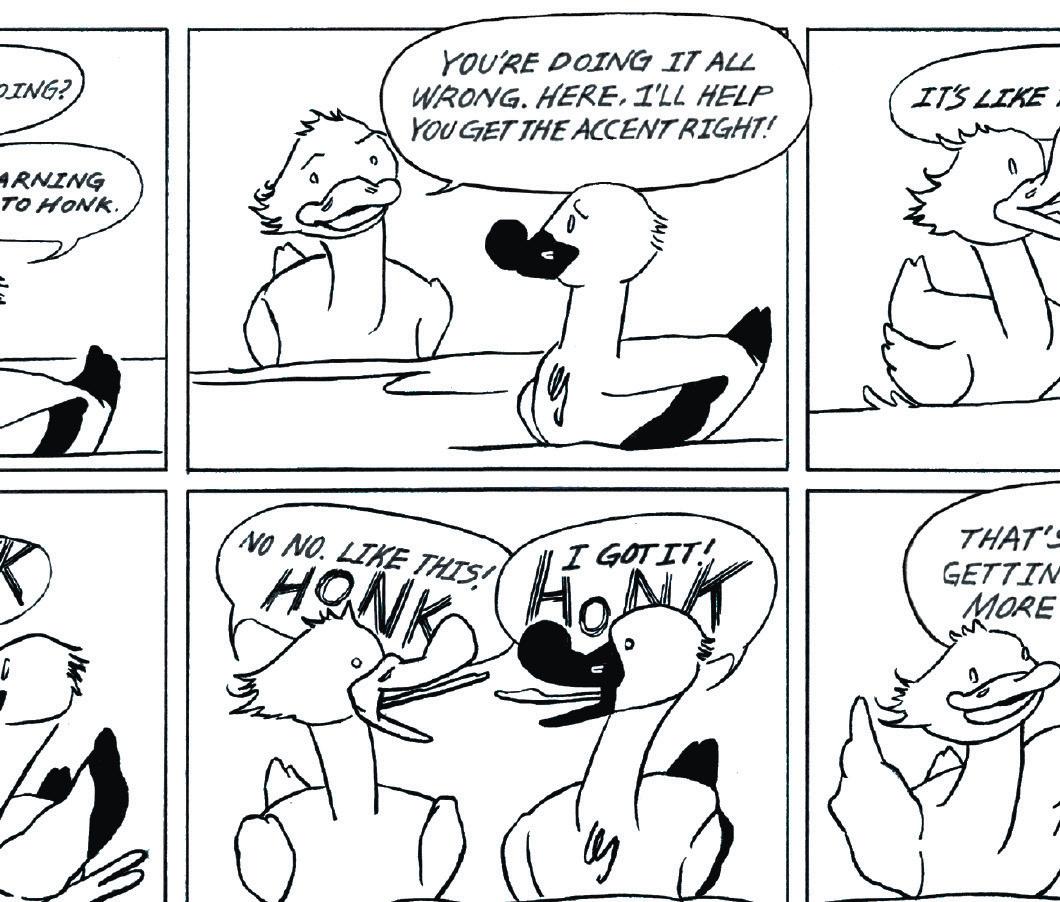

Nathaniel
Nathaniel
The Daily Northwestern
Paired Up
Weekly Crossword: Paired Up By Games Editor
By Miguel Tsang
1 Rolling five of these with the same result gets you a Yahtzee
Minnesota’s MLB team
King Julien’s righthand guy in ‘Madagascar ’
Together, each of this forms a cage
‘Tea’ in Mandarin
First word of Central American country bordering Panama and Nicaragua
Out of the blue
Identity unknown 16 In Japanese, refers to a


Weekly Crossword
out,” Horvath said. “But of course, that’s not a permanent solution. Can’t go on forever.”
Chemical and biological engineering Prof. Jennifer Dunn echoed Horvath’s sentiment. She said she is grateful that NU has gone “beyond what many other universities have done” to support labs like hers.
Dunn researches the environmental impacts and the influence of emerging technologies.
But she knows that NU’s support is not a long-term solution. Because of this, she said she chose to stop one of her research projects focused on carbon capture and storage, a project that has remained in “limbo” since the freeze.
“I opted not to continue to request this support from the University because I’m nearly certain that the project will not be continued,” Dunn said.
Without enough money coming in, Dunn said she did not renew contracts for two staff members in her lab. One was a postdoctoral scholar carrying out carbon capture and storage research, while the other was a research assistant supporting external coordinations.
Furthermore, two Ph.D. students projected to finish their degree in two years are now aiming to complete their degree in one year, Dunn said, because of the uncertainty of funding.
“Overall, my research group will be cut in half between now and one year from now, and so that’ll just influence our ability, in terms of research output,” Dunn said. “Fewer people just means fewer discoveries, fewer ways to interact with the research community.”
Staff cuts, hiring freezes slow research progress
Biomedical engineering Prof. Guillermo Ameer researches regeneration of tissues and organs for reconstructive surgeries. He said his NIH grant has not been directly impacted by the
COUNCIL
From page 1
of respondents were in favor of a grocery tax.
funding freeze, but staff cuts impede his research progress.
Ameer said researchers like him rely on Core Facilities essential for data collection, which contain expensive instruments shared between lab groups. Staff positions maintaining these facilities have been cut, straining the system and causing a backlog on Core equipment, he said.
“The people that we have in the Cores are fantastic, and it took years to build these facilities to support the kind of work that we do at Northwestern,” Ameer said. “These kinds of research enterprises don’t happen by magic. It takes a lot of moving parts, a lot of dedicated people, a lot of resources besides the funding to make it work.”
Now, Ameer said he has to get creative and plan out the next six to nine months to ensure they meet deadlines.
As a researcher that frequently uses Cores to conduct studies, Horvath said staff cuts diminish researchers’ capability to have a “robust and competitive scientific research environment.”
The work of cut staff positions now must be distributed among everyone, he said.
Staff cuts have also slowed grant applications, which require a long process starting with University approval, according to Horvath.
“All of these systems are under stress, so they require us to have our grant applications turned into them way in advance of the deadline, earlier and earlier because they need more time to go through it because they have fewer people to process it, which means that we don’t have as much time to work on it,” Horvath said.
Hiring freezes, lack of proposal requests, leave a gap in fresh talent
Few calls for new research proposals have been sent out by federal agencies like the NSF and Department of Energy, Dunn said. Researchers must submit a substantial amount of proposals in order to successfully receive funds for a few, according to Dunn.
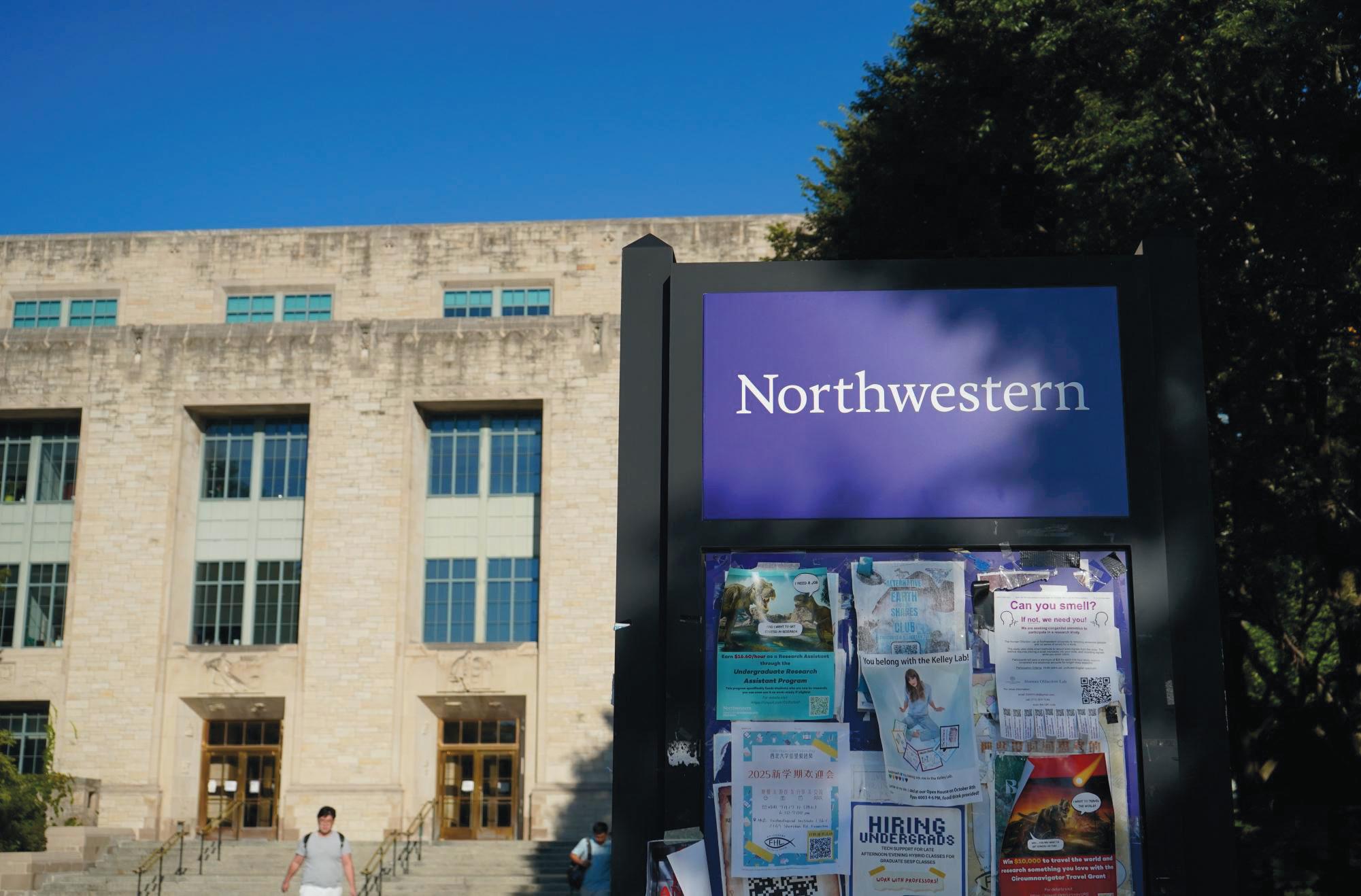
He also said these research project funds pay graduate students and postdocs. Unable to submit new proposals, she did not accept new students into the research group.
The uncertainty doesn’t just affect the present — it also undermines the longevity of research.
“The funding landscape is so uncertain that one year out from now, unless things change, research — not only at Northwestern, but this is true of colleagues I talk with across academia in the United States — is just going to go through a really, really rough patch, to understate it,” Dunn said.
Horvath said the current financial crisis has expanded challenges that arise when people
leave the University, whether retiring or for other opportunities. Positions in the department sometimes take a year to interview and fill, and as the department cannot hire this year, it “trickles back” next year and beyond, Horvath said.
A vulnerable population in this situation is the junior faculty, which Horvath said affects the quality of teaching and research programs in the future.
“It’s harder and harder for them to get support,” Horvath said. “It’s going to create a gap in the pipeline of people who are trained to become scientists in the future.”
ashleywei2028@u.northwestern.edu
Critics of the tax, like Biss, have called the ordinance “regressive” — disproportionately burdening low-income shoppers — and see property taxes as a more equitable solution.
“I am not super happy continuing to tax Evanston residents for groceries, but it was the best of a number of bad options,” Nieuwsma said.
As of Sept. 26, 694 municipalities in Illinois have adopted ordinances for a grocery tax. The city of Chicago has not yet come to a decision about implementing a similar ordinance after the elimination of the statewide grocery tax, but Chicago Mayor Brandon Johnson has publicly supported such a policy, claiming the city would otherwise lose $80 million.
“Nobody’s happy about it, but it was the right call.”
According to the city, only 44% of shoppers at the eight grocery stores in the city are residents. For each individual store, residents also only comprise 17 to 65% of the consumer population. Rodgers suggested that a home rules sales tax would be preferable to a municipal grocery tax, but said a property tax increase was the least favorable option.
“I feel that we’ve kind of been backed into this timeline and are being forced to take a vote that some of us find unpalatable, but is the best of the solutions that we have,” he said. The city’s grocery tax ordinance must be filed with the Illinois Department of Revenue by the Oct. 1 deadline, and the local tax will become effective Jan. 1, 2026.
rubydowling2028@u.northwestern.edu
The Daily Northwestern
THANKS OUR 2024–25 DONORS
We are grateful to the following donors who made contributions to The Daily These gifts were made between May 2, 2024 and May 1, 2025*
Rebecca J. Blondin ’97
Elizabeth Adames
Ivan A. Adames
Mariana Andrea Alfaro Martinez ’18, ’18 MS
JoAnn B. Alexander ’74
Andrea R. Allen ’80 Farrokh Allen
Garland H. Allen ’66
Jessica Lynn Allen ’12
Leslie J. Allen ’83
Joanna Elspeth Allerhand ’07
Katherine Alteneder ’93
American Express Company
American Online Giving Foundation, Inc.
Krishnan M. Anantharaman ’91
Christopher Anderson
Mary Anderson
Melanie Anderson ’82
Charlotte Angiolillo (’27 P)
Michael Angiolillo (’27 P)
Aliza Sarah Appelbaum ’08
Virginia F. Ayers
Liana Rochelle Baker ’10
Timothy John Balk ’18
Bridgett McCarthy Baron ’91 (’25 P)
Matthew Baron ’90 (’25 P)
Kristin Chou Barrett ’06
Michael Philip Beder ’07
Steven Andrew Berger ’10
Beth M. Berk ’85, ’86 MS
Micah Bettenhausen
Nathan Billig
Marti R. Bjornson ’60, ’94 MA
Jeffrey B. Blum
Jessica Paige Bobula ’07, ’08 MS
Susan Elizabeth Boyd ’65
David Braga
Brian Brockway (’21 P)
Ella K. Brockway ’21
Kim Brockway (’21 P)
Mareva Colette Brown ’86, ’87 MS
Martin A. Brown ’72
Julie Browning ’81, ’81 MA (’10 P)
Madeline Kim Burakoff ’20, ’20 MS
Jennifer E. Burke ’96
Robert J. Burow ’59
Craig D. Bustin ’81
Barbara Peterson Byrne ’89, ’02 MD, ’96 GME, ’02 MBA (’20 P)
Elizabeth Clare Byrne ’20
John M. Byrne ’90 (’20 P)
Michael A. Campbell ’80
Stacia G. Campbell ’80
Alena Carroll (’23 P)
Gabriela Libuse Carroll ’23
Michael Carroll (’23 P)
Samuel James Casey
Anne Joan Cauvin (’94 P)
Henri E. Cauvin ’94
Colin Nicholas Ceperich ’87 (’20 P)
Sherry Rae Dyche Ceperich ’86 (’20 P)
Phillip Alexander Cervantes ’24
Jennifer M. Cerven ’85
Brandon Jian Chen ’17
Ken Cheng (’28 P)
Victor J. Chi ’91
Jiin-Huey Esther Chou Tanaka ’03
Alvin F. Chow ’84, ’94 MBA
Douglas J. Clancy ’76 MS
Russell A. Clemings ’78
Douglas J. Cohen ’97
Marshall Jacob Cohen ’14
Tom Collinger
Christina Combe
Christopher B. Combe ’70 (’99, ’06, ’09 P), Trustee
The Community Foundation for Greater Atlanta
Elizabeth L. Coney ’76 MBA (’15 P)
Jeffrey P. Coney ’74, ’76 MBA (’15 P)
Mary Carole Cooney
Patrick Cooper ’02, ’02 MS
Jonathan R. Copulsky
Alicia Cordova ’10
Tracy Cosgrove ’87
Ronald James Cox ’55
Barbara Craig ’82
David A. Craig ’82
Andrew R. Croop
Kari Croop ’99
Dennis Culloton ’87
Kevin M. Daniels ’95
Monica Davey
Richard S. Davis ’81, ’84 JD
Mary L. Dawson ’75
Elise Katherine De Los Santos ’12, ’25 MA
Stacey B. Delo ’96
Stephan Clark Dimos
Charley H. Ding ’01, ’05 MD
Continued on the opposite page
Erin Ding ’03
Madelyn Dinnerstein ’83
Chip Dombrowski ’97, ’99 MS
Virginia A. Donohue ’81, ’83
*Every effort was made to recognize all who donated between May 2, 2024 and May 1, 2025. If you believe your gift was not recognized, have any questions or would like to donate, email campaignfuture@dailynorthwestern.com or call 847-491-7206 and leave a message. Support the future of The
The Daily Northwestern THANKS OUR 2024–25 DONORS
We are grateful to the following donors who made contributions to The Daily. These gifts were made between May 2, 2024 and May 1, 2025.* Continued from the opposite page.
Alvin From ’65, ’65 MS
Haley E. Fuller ’22, ’23 MS
Phyllis Funkenbusch
Kathleen Galbraith ’91
Elizabeth Rome Galentine ’06
Ahthony M. Gama-Lobo ’95, ’95 MA
Rebecca May Gama-Lobo ’95
Olga L. Garnhart ’99
Mark C. Gelatt ’84
Lisa George
Stephen H. George ’88
Anita Gewurz ’85 GME
Henry Gewurz
Jonathan Gewurz
Luisa Ginnetti ’72
Geoffrey A. Glatt ’69
Hayley Susanne Glatter ’16
Allan R. Gold ’77, ’78 MS (’24 P)
Ania Gold (’24 P)
Shari R. Goldhagen ’98
Deana Goldstein
Judi Gordon
Mark Gordon
Jorin Graham
Shane D. Graham ’94
Wendy Gray
Adam L. Grayson ’01
Andrew Thomas Grayson ’01
Anne S. Greenberg ’79
Aviva L. Gutnick ’95
Lonnie E. Haefner ’63, ’69 PhD (’93 P)
V. Jean Haefner (’93 P)
Kerin Hagan ’79
William P. Halldin ’84
Patricia J. Handeland
George H. Harmon
Amy Johnson Harrell ’95
Mark D. Hassakis
Patricia Hastings
Peter Kent Hawryluk ’07 MBA
Maxwell Ganz Hayman ’09
Amy A. Healey ’78
Brenna Jeanette Helppie-Schmieder ’11, ’16 JD
Malia Rulon Herman ’98
Annika Narendra Hiredesai ’23
Clint C. Holder ’94
Hilary Holder ’94, ’99 MA
Neil D. Holdway ’92
David Honderich
Jennifer P. Hontz ’93
Gina F. Ikenberry (’26, ’27 P)
John Paul Ikenberry ’91 (’26, ’27 P)
Karen Infeld Blum ’92, ’93 MS
Aaron Lawrence Jaffe ’89
Elizabeth A. Jensen ’81
Jewish Communal Fund
Beverly K. Johnson (’20 P)
Vincent E. Johnson ’89
Andrew Johnston (’27 P)
Daniel S. Jones ’60 (’91 P)
Gregory Neil Jonsson ’00, ’01 MS
Gerald B. Jordan ’71 MS
Pradnya K. Joshi ’93, ’94 MS
JP Morgan Charitable Giving Fund
Michael L. Kahn ’96
Avani Desai Kalra ’25
David Y. Kan ’95, ’99, ’99 MD
Grace Kan
John D. Kann ’86 MBA
Lori H. Kann
Amber Kasses
Glenn Kasses ’03
Eskander Kazim (’27 P)
Terrence J. Kelleher
Evan M. Kent
Karen Zak Kent ’78, ’78 MS, ’82 DDS
Roma Khanna ’00, ’11 MS
Stephen W. Kiehl ’99
Andrew Keith
Suzanna Keith
David Kelso
Junu Kim ’86, ’87 MS
Joan King Salwen ’82 (’17 P)
Elizabeth June Kirk ’06
Daniel Kirwan (’28 P)
Kristen Kirwan (’28 P)
Kristina M. Kluetmeier ’86
William Frank Kobin ’18
Danika Koenig ’05
Peter Kotecki ’18
G. Lionel Kramer ’52, ’53 MS
Sheryl Krsticevic ’81
Angie M. Kucharski ’87, ’88 MS
Erin Kathleen Kuller ’09
Marian Kurz
Cayla Emma Labgold-Carroll ’28
Cliff Lachman (’25 P)
Margot Lachman ’87, ’88 MS (’25 P)
Craig Llewellyn Lamay
Karen H. Laner ’80
Alicia Lasek ’90 MS
Mark Russell Lazerus ’01
Candy Lee
Alan R. Leff (’03 P)
Donna Rosene Leff ’70, ’71 MS (’03 P)
Catherine Leffler
Robert W. Lehner ’73, ’76 MBA
Brian R. Leighton ’84
Philip A. Lentz ’72
Jennifer V. Lescott
Carl P. Leubsdorf
Thomas N. Lin ’95
Graham B. LippSmith ’99
MaryBeth LippSmith ’99
Amy Y. Liu ’97
Tyler James Lockman ’19 MS
Patricia Ann Loew
Bret V. Luboyeski ’01
John W. Luttermoser ’79
Margie MacNeille
Stewart L. Mandel ’98
Alison Margello (’27 P)
Nicole Jane Markus ’25
Jonathan Herbert Marshall ’91 MS
Marydelia Marshall
Anne Louise Martin ’09, ’09 MS
Michael Martinez ’83
Craig S. Matsuda ’77, ’78 MS
David M. Mazie ’55, ’56 MS
Maris Friedenberg Mazie
Lark Vidette McCarthy ’75, ’76 MS M. Yasmina McCarty ’00
Charles A. McCutcheon ’85
Janet S. McDonald
Stephen E. McDonald ’82 MBA
Ellen H. McEvily ’84 (’14 P)
Michael McEvily (’14 P)
Flynn W. McRoberts ’89
Stephanie Nicolas Mehta ’91, ’92 MS
Nomaan Merchant ’09
Naila-Jean C. Meyers ’00
David W. Mildenberg ’81
Angeli Mittal ’24, ’24 MS
Rani C. Monson ’96
Tom Moran
Morgan Stanley Global Impact Funding Trust Inc.
Joshua Campbell Moshier ’08
Tomoko Hosaka Mullaney ’99
Jennifer L. Mullman ’99
Jeremy S. Mullman ’00
Megan Danielle Munce ’22, ’22 MS
Jonathan E. Murray ’03
David E. Nathan ’83
National
Susan H. J. Nathan
Philanthropic Trust DAF
Louise Nelson
Mark E. Nelson ’90
Joel A. Nierman ’04
Melissa Nook (’28 P)
William Nook (’28 P)
Teresa Ann Norton ’67
Nuala O'Connor
Caroline H. Ogburn (’26 P)
Chris Ogburn
Staci Ogburn
Stephen Ogburn
Tom E. Ogburn (’26 P)
Vincent P. O'Hern ’65
Sarah Okeson ’88
Barbara K. Oliver
Richard L. Oliver ’72, ’79 MBA
Jennifer O'Neil
Allison Orenstein ’94
David J. Orenstein ’94, ’94 MS
Emiline R. Ott ’61
Marvin Ott
Levent Ozgur ’01
Robert M. Packer ’81
Christopher Page
Susan L. Page ’73
Tyler Benjamin Pager ’17
Julie Paget
Jerome Curran Pandell ’05
Bruce B. Pascoe ’87 (’24 P)
Mary Scott Patronik ’88, ’97 MBA (’21, ’23 P)
Timothy J. Patronik ’87 (’21, ’23 P)
Laurel Thompson Paul ’92
Peter J. Pawinski ’98
Julie Payton (’27 P)
Nancy Jean Pendergrass ’85
Andrew C. Peng ’00
Patrizia
Angela Pensa ’00, ’12 MA
Daniel Perez (’20 P)
Olga Perez (’20 P)
Suzanne C. Peterson ’89
Cynthia M. Phelan ’88
Thomas S. Philp ’83
Jennifer Lynne Pilat ’05
Amy C. Poland ’87, ’90 MS (’17, ’19 P)
Douglas M. Poland ’88 (’17, ’19 P)
Carrie Ralstin Porter ’09
Anna Claire Prior ’08
Barbara N. Purdy (’05 P)
David Mark Purdy ’74 (’05 P)
James M. Puzzanghera ’85
Elisa Miller Quinlan ’98
Camilla Rab
Joan Radovich ’84
Lydia Charlotte Ramsey Pflanzer ’15
John A. Ranieri ’81
Manuel Mopas Rapada ’15, ’15 Cert
Connie Reddicliffe (’13 P)
Steven V. Reddicliffe ’75 (’13 P)
Heather Reid ’94
Amy B. Reinholds ’92
Scott Russell Reiter ’95
Kristoffer Ljones Resellmo ’03
Dorothy S. Ridings ’61
Katherine E. Ritchey ’00, ’01 MS
Jennifer Magat Ro ’93, ’94 MA (’28 P)
Jun H. Ro ’92 (’28 P)
Arnold Jeffrey Robbins ’75 JB Roberts ’89
Jose L. Rodriguez ’84
Charles G. Rogalske ’67
Mary Ann Rogalske
Christina Lauren Rosales ’11
Robert G. Rosenbaum ’84
Benjamin X. Rosenberg ’21
Amy Rosewater Halushka ’93, ’94 MS
Kathryn Rospond Roberts ’92
James M. Ross ’89
Melanie Fridl Ross ’89, ’90 MS
Rita L. Rubin ’78
Nathaniel J. Ryan ’95
Jennifer Clare Sakhnovsky ’15
Kevin G. Salwen ’79 (’17 P) Adrienne Samuels-Gibbs ’99
James D. Saunders ’88
Michael H. Schill Trustee
Daniel H. Schlueter (’26 P)
Gayle H. Schlueter (’26 P)
Peter A. Schoenke ’92, ’93 MS
Jill Schoenwetter
Paul Schoenwetter
Carly R. Schulman ’22
Elliot Schwartz
Andrew Michael Scoggin ’11
Christine E. Seliga ’87 (’24 P)
David C. Sell ’85
Gail S. Sell
Nilay Sen (’17, ’21, ’22 P)
Suat Sen (’17, ’21, ’22 P)
Gregory Shea ’95
John Shea ’96 MS
Janine M. Sieja ’88
Ann H. Silverberg ’74, ’75 MS
Nat J. Silverman ’72, ’74 MS
Andrew Markowitz Simon ’09
Gloria Sin (’28 P)
Stephen K. Sink ’69, ’70 MS
Bonnie J. Sinnock ’89
Peter D. Slevin
Amy Kossoff Smith ’89
Barbara Nordby Soderlin ’99
Josh Abraham Solomon ’14
The Daily is produced in the THE HOLLY & JOHN MADIGAN NEWSROOM OF THE DAILY NORTHWESTERN University Library Archives of The Daily were digitized thanks to a generous gift from DANIEL S. JONES The Daily is supported by the ED BRYANT MEMORIAL FUND
*Every effort was made to recognize all who donated between May 2, 2024 and May 1, 2025. If you believe your gift was not recognized, have any questions or would like to donate, email campaignfuture@dailynorthwestern.com or call 847-491-7206 and leave a message.
MEN’S SOCCER

MISSED OPPORTUNITIES
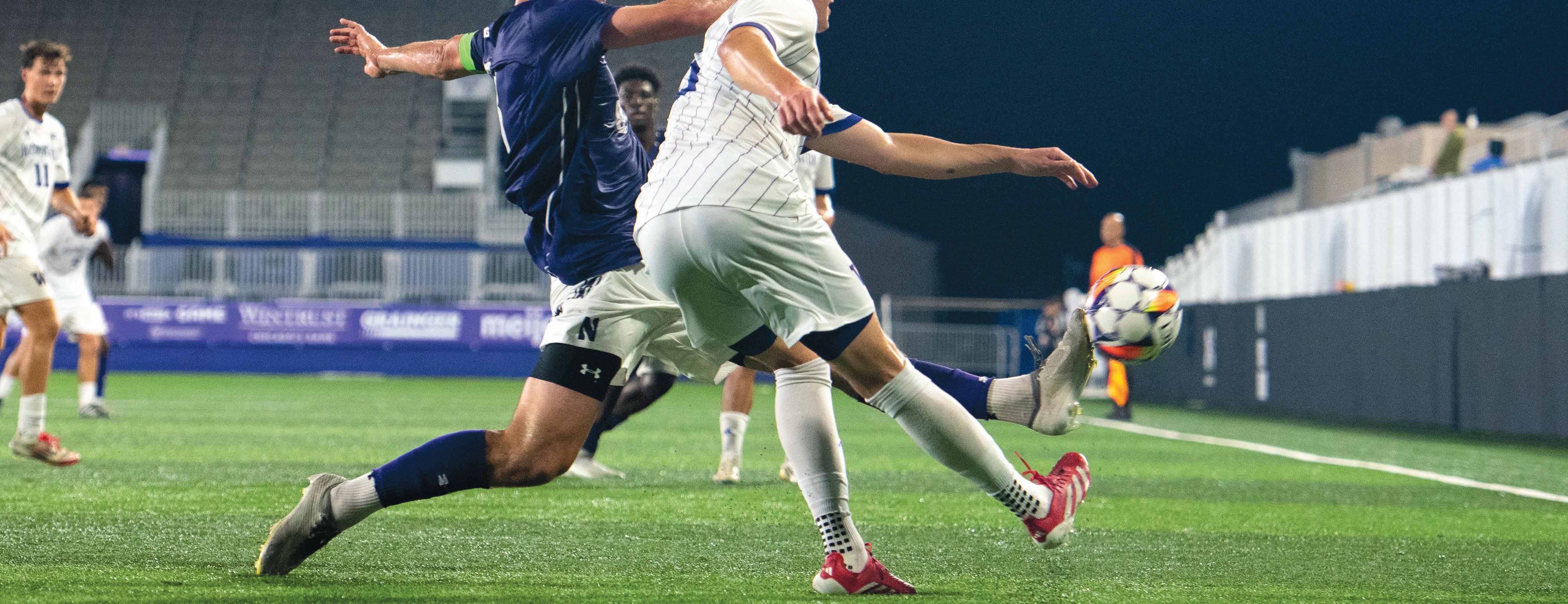
Plenty of possession, but few shots made
By ELI KRONENBERG and YONI ZACKS the daily northwestern
@elikronenberg / @yonizreports
Northwestern had its way for much of Monday evening’s home clash with Washington, outshooting its guests 19-8 and controlling 61% of the possession. But, as the nal whistle blew, it was the Huskies (6-3-2, 3-1-0 Big Ten) who came away with all three points, propelled by a scrappy rst-half set piece goal.
e Wildcats (5-4-1, 1-3-0 Big Ten) were le regre ing missed opportunities as they dropped their third of four Big Ten contests.
Washington center back Harrison Bertos provided decisive touches in both goalmouths, bundling in the game’s lone goal and making two lastditch goal-line clearances.
A er the match, coach Russell Payne lauded his team’s a acking intent but lamented that it only managed to put six of its 19 shots on target.
“I’m proud of the guys in terms of taking the game to Washington, but that’s an expectation for us,” Payne said. “And the other expectation is we keep our shots on target, we win that game.”
e rst half took on a frenetic quality, with transition opportunities and clear-cut chances aplenty for both teams.
e ’Cats put the pressure on early, with a lefooted chest-down-and-volley by senior mid elder Doug Hainer stopped by Washington goalkeeper
Back
By KATIE WHITAKER
A er a heated back-and-forth exchange of points in the rst three sets Sunday, Northwestern had nally reached match point in the fourth, leading by two sets to one. e score was 24-22, Wildcats (11-3, 1-1 Big Ten).
All eyes were on junior libero Drew Wright as she served the point that could close out the ’Cats’ rst Big Ten victory of the season. A ention shi ed as the ball she served soared well beyond the net and over the Ducks’ (9-3, 0-2 Big Ten) heads. Out. Wright’s service error came on the rst of the four match points that would conclude the set. A er a quick NU timeout, Oregon was able to block an a ack by senior outside hi er Rylen Reid, denying NU its second opportunity to seal the match and tying the score 24-24.
On NU’s third and fourth match points of the set, Ducks outside hi er Valentina Vaulet delivered kills to keep the visitors alive. An ace on Oregon’s second set point wrapped up the set.
A er coming back from two-sets-to-none down and saving ve match points to level the match, all the momentum stood on the Ducks’ side. But the ’Cats dug deep, regaining their best form in the h set en route to a rollercoaster 25-22, 25-21, 24-26, 27-29, 15-10 victory.
“It’s good to get one under your belt,” secondyear coach Tim Nollan said postgame. “ ey
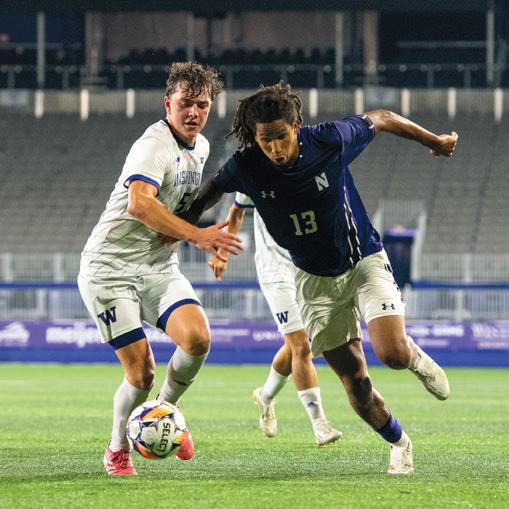
Levi Bieber. Graduate student mid elder and captain Joe Suchecki pounced on the rebound with a header that Bertos re exively cleared o the line.
In the 22nd minute, the Huskies found themselves on the a ack when mid elder Joe Dale raced through on goal from the right and red a de ected e ort just over the crossbar.
Washington took the ensuing corner short to mid elder Alex Hall, who clipped an outswinging cross into the 6-yard-box, where Bertos continued his end-to-end play by heading the ball toward the net.
Senior goalkeeper Rafael Ponce de León re exively parried the close-range header, but it de ected back o of Bertos and dribbled into the back of the net. As Bertos celebrated by running toward the bench, he blew a kiss to a pack of young NU fans. Bertos’ superb night continued minutes later
NEXT UP Tuesday
Versus Evansville, 6:30 p.m. Saturday, Oct. 11
Versus Michigan State, 6:30 p.m.
RECORD
5-4-1 overall, 1-3-0 Big Ten
when he headed senior center back Nigel Prince’s set piece away from the goal line.
In the second half, the two teams traded chances up and down the eld before Washington began one of its signature counter-a acks in the 63rd minute. As the Huskies sprinted up the pitch, the ’Cats defense scrambled to recover, but Ponce de León sprinted o his line and bailed them out with an impressive save.
“You can call any coach in the league, Washington’s special quality is counters,” Payne said. “You’re not gonna stop their counters. You’re going to minimize some of their counters.”
e ’Cats’ greatest chance of the second half came in the 73rd minute. Senior forward Alejandro Martinez Santamaria played a pair of one-twos with substitute junior mid elder Peter Riesz and Suchecki that set him free on the le side of the penalty area,
but Bertos was able to block his le -footed strike with another piece of defensive heroics.
As the game neared the 90th minute, the ’Cats continued to press while Washington fell back into a low defensive block. Substitute sophomore forward Omar Jallow and junior right back Bryant Mayer were two of the many players who tried but failed to break the Huskies’ wall.
Following the nal whistle, Payne and his team gathered for a prolonged huddle, with NU’s coach becoming animated near its conclusion. Payne said the players took the lead in analyzing where they had room for improvement.
“ e biggest message that they came up with, that I just reinforced, was dependability,” Payne said. “Everyone has to be dependable in their role… and enough of the guys, especially some of the older guys who weren’t afraid to show ownership, pinpointed what they needed to do be er and then tried to encourage the team to have that same level of ownership.”
NU returns to Martin Stadium for a non-conference matchup against Evansville next Tuesday at 6:30 p.m. Payne said he would be paying li le a ention to the team lining up on the other side of the pitch, regardless of opponent.
“I don’t need to see another opponent’s name listed on the rest of the schedule,” Payne said. “It’s us versus us.”
elikronenberg2027@u.northwestern.edu yonizacks2029@u.northwestern.edu
always say the rst one’s the hardest one, so now we’ve got this one out of the way.”
Junior outside hi er Campbell Paris scored the rst point of the match for NU with a decisive kill, but from there the set devolved into a series of scrappy rallies, with the ’Cats and the Ducks trading o on short runs.
e end of the rst set was marked by timeouts as each team experienced serving and serve receive errors that kept them close. At game point, with NU leading 24-22, Oregon used its nal timeout before hi ing the ball out of bounds a er freshman libero Lauren Dignan served. e ’Cats won the opener 25-22. NU returned Oregon’s rst serve of set 2 with a kill by graduate student middle blocker Bella Simkus. A er each team went on a three-point run, an ace by Oregon opposite Alanah Clemente tied the game 7-7.
A er two service errors and two more kills from Ducks outside hi er Sophia Meyers, the score held tied at 9-9 before two key blocks by Paris and freshman middle blocker Kayla Kau man, as well as a kill by fellow freshman outside hi er Bella Bullington.
Graduate student outside hi er Ayah Elnady fought Vaulet’s kill and block with two kills of her own, bringing the game to a tense 21-21. A er NU senior outside hi er Kathryn Randorf joined the game to serve, a bad set by Oregon’s se er, junior Cora Taylor, meant victory for the ’Cats in set 2.
Another back-and-forth point exchange began
the third set, with an unorthodox underhand slap play by Oregon and a net violation by NU only adding to the scrappy feel of the set.
At set point, with Oregon leading 24-23, NU called a timeout, before an Oregon service error leveled the score. However, a tricky se er dump by Oregon and a decisive block touch on the Ducks’ second set point clinched a 26-24 set.
Set 4 presented another opportunity for a ’Cats win, and both teams looked strong as the score climbed in roughly two point bursts from each throughout the game. Nollan said Oregon’s service pressure helped them claw back from two sets down to force a h and that he told his team to hit the reset bu on entering the nal set.
“We decided to get back to controlling our side a li le bit be er and going back to executing the simple things,” said Nollan. e h set came as a relief, to the fans and to the players, no doubt exhausted a er two hours of seesaw scores. Beginning with a clean ace from Elnady, a short exchange ensued until a series of errors, in addition to three well-placed kills — two by Bullington, one by Elnady — forced an Oregon timeout as NU se led into a comfortable lead at 9-4. ough the Ducks came back from their timeout with a powerful point, they also granted the ’Cats an immediate side-out through a service error by Clemente. ough Oregon challenged, the call was again con rmed.
Another kill from Elnady, her 16th and nal of the game, prompted another Oregon timeout,
with NU ahead 11-5. Despite two more Oregon kills from middle blocker Holley McFadden and Clemente, NU took the set and the match with a kill by Bullington.
Nollan credited a combination of strong blocking and an e ective a ack line with the win.
“I’m proud of our blockers. Registering 11 blocks against a really physical a acking team, you know, Oregon gets a er you from the service line,” Nollan said.
Nollan said he was happy with the team’s a acking statistics, with 60 kills, 14 errors, 132 a acks and a .348 hi ing percentage, calling it a “great a ack line.”
While Nollan commended all three regular-playing freshmen on their contributions to the team thus far, he said Bullington was a standout player in the a ernoon’s game with a .500 hi ing percentage.
“I’m always swinging as hard as I can,” said Bullington. “I know who I am and I know that I can play at high levels.”
Both Nollan and Bullington said they are looking forward to bringing a strong a acking line to Friday’s game against Michigan State, as well as building on consistent blocking.
To Nollan and the program as a whole, this win is a crucial one.
“We have big dreams of going to the NCAA tournament this year,” Nollan said. “ ese are the matches we need to accomplish that.”
katiewhitaker2029@u.northwestern.edu
